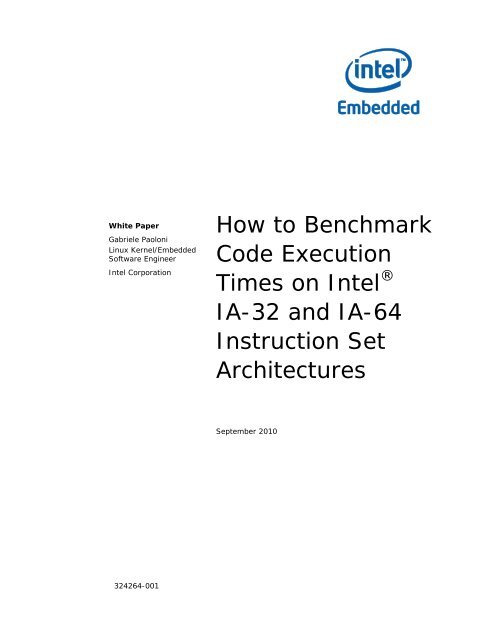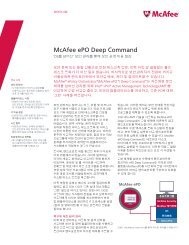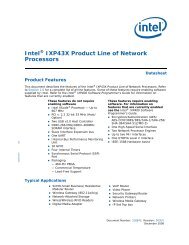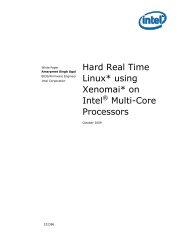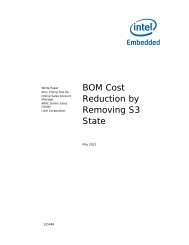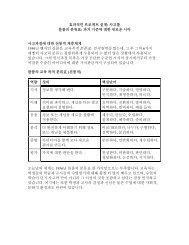How to Benchmark Code Execution Times on Intel IA-32 and IA-64 ...
How to Benchmark Code Execution Times on Intel IA-32 and IA-64 ...
How to Benchmark Code Execution Times on Intel IA-32 and IA-64 ...
You also want an ePaper? Increase the reach of your titles
YUMPU automatically turns print PDFs into web optimized ePapers that Google loves.
White Paper<br />
Gabriele Paol<strong>on</strong>i<br />
Linux Kernel/Embedded<br />
Software Engineer<br />
<strong>Intel</strong> Corporati<strong>on</strong><br />
<str<strong>on</strong>g>How</str<strong>on</strong>g> <str<strong>on</strong>g>to</str<strong>on</strong>g> <str<strong>on</strong>g>Benchmark</str<strong>on</strong>g><br />
<str<strong>on</strong>g>Code</str<strong>on</strong>g> <str<strong>on</strong>g>Executi<strong>on</strong></str<strong>on</strong>g><br />
<str<strong>on</strong>g>Times</str<strong>on</strong>g> <strong>on</strong> <strong>Intel</strong> ®<br />
<strong>IA</strong>-<strong>32</strong> <strong>and</strong> <strong>IA</strong>-<strong>64</strong><br />
Instructi<strong>on</strong> Set<br />
Architectures<br />
September 2010<br />
<strong>32</strong>42<strong>64</strong>-001
<str<strong>on</strong>g>How</str<strong>on</strong>g> <str<strong>on</strong>g>to</str<strong>on</strong>g> <str<strong>on</strong>g>Benchmark</str<strong>on</strong>g> <str<strong>on</strong>g>Code</str<strong>on</strong>g> <str<strong>on</strong>g>Executi<strong>on</strong></str<strong>on</strong>g> <str<strong>on</strong>g>Times</str<strong>on</strong>g> <strong>on</strong> <strong>Intel</strong> ® <strong>IA</strong>-<strong>32</strong><br />
<strong>and</strong> <strong>IA</strong>-<strong>64</strong> Instructi<strong>on</strong> Set Architectures<br />
Abstract<br />
This paper provides precise methods <str<strong>on</strong>g>to</str<strong>on</strong>g> measure the clock cycles spent<br />
when executing a certain C code <strong>on</strong> a Linux* envir<strong>on</strong>ment with a generic<br />
<strong>Intel</strong> architecture processor (either <strong>32</strong> bits or <strong>64</strong> bits).<br />
2
<str<strong>on</strong>g>How</str<strong>on</strong>g> <str<strong>on</strong>g>to</str<strong>on</strong>g> <str<strong>on</strong>g>Benchmark</str<strong>on</strong>g> <str<strong>on</strong>g>Code</str<strong>on</strong>g> <str<strong>on</strong>g>Executi<strong>on</strong></str<strong>on</strong>g> <str<strong>on</strong>g>Times</str<strong>on</strong>g> <strong>on</strong> <strong>Intel</strong> ® <strong>IA</strong>-<strong>32</strong><br />
<strong>and</strong> <strong>IA</strong>-<strong>64</strong> Instructi<strong>on</strong> Set Architectures<br />
C<strong>on</strong>tents<br />
1 0BIntroducti<strong>on</strong> .................................................................................................. 5<br />
1.1 Purpose/Scope ..................................................................................... 5<br />
1.2 Assumpti<strong>on</strong>s......................................................................................... 5<br />
1.3 Terminology ......................................................................................... 5<br />
2 Problem Descripti<strong>on</strong> ...................................................................................... 7<br />
2.1 Introducti<strong>on</strong> ......................................................................................... 7<br />
2.2 Problems with RDTSC Instructi<strong>on</strong> in C Inline Assembly ............................... 7<br />
3 Variance Introduced by CPUID <strong>and</strong> Improvements with RTDSCP Instructi<strong>on</strong>11<br />
3.1 Problems with the CPUID Instructi<strong>on</strong> ...................................................... 11<br />
3.1.1 <str<strong>on</strong>g>Code</str<strong>on</strong>g> Analysis ......................................................................... 11<br />
3.1.2 Evaluati<strong>on</strong> of the First <str<strong>on</strong>g>Benchmark</str<strong>on</strong>g>ing Method .............................. 12<br />
3.2 Improvements Using RDTSCP Instructi<strong>on</strong> ............................................... 15<br />
3.2.1 The Improved <str<strong>on</strong>g>Benchmark</str<strong>on</strong>g>ing Method ......................................... 16<br />
3.2.2 Evaluati<strong>on</strong> of the Improved <str<strong>on</strong>g>Benchmark</str<strong>on</strong>g>ing Method ...................... 17<br />
3.2.3 An Alternative Method for Architecture Not Supporting RDTSCP ..... 20<br />
3.2.4 Evaluati<strong>on</strong> of the Alternative Method ......................................... 22<br />
3.3 Resoluti<strong>on</strong> of the <str<strong>on</strong>g>Benchmark</str<strong>on</strong>g>ing Methodologies ....................................... 24<br />
3.3.1 Resoluti<strong>on</strong> with RDTSCP ........................................................... 24<br />
3.3.2 Resoluti<strong>on</strong> with the Alternative Method ...................................... 27<br />
4 5BSummary ..................................................................................................... 30<br />
5 Appendix ..................................................................................................... 31<br />
6 Reference List .............................................................................................. 35<br />
Figures<br />
Figure 1. Minimum Value Behavior Graph 1 .................................................................. 14<br />
Figure 2. Variance Behavior Graph 2 ............................................................................ 15<br />
Figure 3. Minimum Value Behavior Graph 3 .................................................................. 19<br />
Figure 4. Variance Behavior Graph 4 ............................................................................ 20<br />
Figure 5. Minimum Value Behavior Graph 5 .................................................................. 23<br />
Figure 6. Variance Behavior Graph 6 ............................................................................ 23<br />
Figure 7. Minimum Value Behavior Graph 7 .................................................................. 26<br />
Figure 8. Variance Behavior Graph 8 ............................................................................ 27<br />
Figure 9. Variance Behavior Graph 9 ............................................................................ 28<br />
3
<str<strong>on</strong>g>How</str<strong>on</strong>g> <str<strong>on</strong>g>to</str<strong>on</strong>g> <str<strong>on</strong>g>Benchmark</str<strong>on</strong>g> <str<strong>on</strong>g>Code</str<strong>on</strong>g> <str<strong>on</strong>g>Executi<strong>on</strong></str<strong>on</strong>g> <str<strong>on</strong>g>Times</str<strong>on</strong>g> <strong>on</strong> <strong>Intel</strong> ® <strong>IA</strong>-<strong>32</strong><br />
<strong>and</strong> <strong>IA</strong>-<strong>64</strong> Instructi<strong>on</strong> Set Architectures<br />
Tables<br />
Figure 10. Variance Behavior Graph 10 ........................................................................ 29<br />
Table 1. List of Terms .................................................................................................. 5<br />
4
<str<strong>on</strong>g>How</str<strong>on</strong>g> <str<strong>on</strong>g>to</str<strong>on</strong>g> <str<strong>on</strong>g>Benchmark</str<strong>on</strong>g> <str<strong>on</strong>g>Code</str<strong>on</strong>g> <str<strong>on</strong>g>Executi<strong>on</strong></str<strong>on</strong>g> <str<strong>on</strong>g>Times</str<strong>on</strong>g> <strong>on</strong> <strong>Intel</strong> ® <strong>IA</strong>-<strong>32</strong><br />
<strong>and</strong> <strong>IA</strong>-<strong>64</strong> Instructi<strong>on</strong> Set Architectures<br />
1 0BIntroducti<strong>on</strong><br />
1.1 Purpose/Scope<br />
The purpose of this document is <str<strong>on</strong>g>to</str<strong>on</strong>g> provide software developers with precise<br />
methods <str<strong>on</strong>g>to</str<strong>on</strong>g> measure the clock cycles required <str<strong>on</strong>g>to</str<strong>on</strong>g> execute specific C code in a Linux<br />
envir<strong>on</strong>ment running <strong>on</strong> a generic <strong>Intel</strong> architecture processor. These methods can<br />
be very useful in a CPU-benchmarking c<strong>on</strong>text, in a code-optimizati<strong>on</strong> c<strong>on</strong>text, <strong>and</strong><br />
also in an OS-tuning c<strong>on</strong>text. In all these cases, the developer is interested in<br />
knowing exactly how many clock cycles are elapsed while executing code.<br />
At the time of this writing, the best descripti<strong>on</strong> of how <str<strong>on</strong>g>to</str<strong>on</strong>g> benchmark code<br />
executi<strong>on</strong> can be found in [1]. Unfortunately, many problems were encountered<br />
while using this method. This paper describes the problems <strong>and</strong> proposes two<br />
separate soluti<strong>on</strong>s.<br />
1.2 Assumpti<strong>on</strong>s<br />
In this paper, all the results shown were obtained by running tests <strong>on</strong> a platform<br />
whose BIOS was optimized by removing every fac<str<strong>on</strong>g>to</str<strong>on</strong>g>r that could cause<br />
indeterminism. All power optimizati<strong>on</strong>, <strong>Intel</strong> Hyper-Threading technology,<br />
frequency scaling <strong>and</strong> turbo mode functi<strong>on</strong>alities were turned off.<br />
The OS used was openSUSE* 11.2 (linux-2.6.31.5-0.1).<br />
1.3 Terminology<br />
Table 1 lists the terms used in this document.<br />
Table 1. List of Terms<br />
Term<br />
Descripti<strong>on</strong><br />
CPU<br />
Central Processing Unit<br />
<strong>IA</strong><strong>32</strong><br />
<strong>Intel</strong> <strong>32</strong>-bit Architecture<br />
<strong>IA</strong><strong>64</strong><br />
<strong>Intel</strong> <strong>64</strong>-bit Architecture<br />
GCC<br />
GNU* Compiler Collecti<strong>on</strong><br />
ICC<br />
<strong>Intel</strong> C/C++ Compiler<br />
5
<str<strong>on</strong>g>How</str<strong>on</strong>g> <str<strong>on</strong>g>to</str<strong>on</strong>g> <str<strong>on</strong>g>Benchmark</str<strong>on</strong>g> <str<strong>on</strong>g>Code</str<strong>on</strong>g> <str<strong>on</strong>g>Executi<strong>on</strong></str<strong>on</strong>g> <str<strong>on</strong>g>Times</str<strong>on</strong>g> <strong>on</strong> <strong>Intel</strong> ® <strong>IA</strong>-<strong>32</strong><br />
<strong>and</strong> <strong>IA</strong>-<strong>64</strong> Instructi<strong>on</strong> Set Architectures<br />
Term<br />
RDTSCP<br />
Descripti<strong>on</strong><br />
Read Time-Stamp Counter <strong>and</strong> Processor ID <strong>IA</strong> assembly instructi<strong>on</strong><br />
RTDSC<br />
Read Time-Stamp Counter <strong>and</strong> Processor ID <strong>IA</strong> assembly instructi<strong>on</strong><br />
6
<str<strong>on</strong>g>How</str<strong>on</strong>g> <str<strong>on</strong>g>to</str<strong>on</strong>g> <str<strong>on</strong>g>Benchmark</str<strong>on</strong>g> <str<strong>on</strong>g>Code</str<strong>on</strong>g> <str<strong>on</strong>g>Executi<strong>on</strong></str<strong>on</strong>g> <str<strong>on</strong>g>Times</str<strong>on</strong>g> <strong>on</strong> <strong>Intel</strong> ® <strong>IA</strong>-<strong>32</strong><br />
<strong>and</strong> <strong>IA</strong>-<strong>64</strong> Instructi<strong>on</strong> Set Architectures<br />
2 Problem Descripti<strong>on</strong><br />
This secti<strong>on</strong> explains the issues involved in reading the timestamp register <strong>and</strong><br />
discusses the correct methodology <str<strong>on</strong>g>to</str<strong>on</strong>g> return precise <strong>and</strong> reliable clock cycles<br />
measurements. It is expected that readers have knowledge of basic GCC <strong>and</strong> ICC<br />
compiling techniques, basic <strong>Intel</strong> assembly syntax, <strong>and</strong> AT&T* assembly syntax.<br />
Those not interested in the problem descripti<strong>on</strong> <strong>and</strong> method justificati<strong>on</strong> can skip<br />
this secti<strong>on</strong> <strong>and</strong> go <str<strong>on</strong>g>to</str<strong>on</strong>g> Secti<strong>on</strong> 3.2.1 (if their platform supports the RDTSCP<br />
instructi<strong>on</strong>) or Secti<strong>on</strong> 3.2.3 (if not) <str<strong>on</strong>g>to</str<strong>on</strong>g> acquire the code.<br />
2.1 Introducti<strong>on</strong><br />
<strong>Intel</strong> CPUs have a timestamp counter <str<strong>on</strong>g>to</str<strong>on</strong>g> keep track of every cycle that occurs <strong>on</strong><br />
the CPU. Starting with the <strong>Intel</strong> Pentium ® processor, the devices have included a<br />
per-core timestamp register that s<str<strong>on</strong>g>to</str<strong>on</strong>g>res the value of the timestamp counter <strong>and</strong><br />
that can be accessed by the RDTSC <strong>and</strong> RDTSCP assembly instructi<strong>on</strong>s.<br />
When running a Linux OS, the developer can check if his CPU supports the RDTSCP<br />
instructi<strong>on</strong> by looking at the flags field of “/proc/cpuinfo”; if rdtscp is <strong>on</strong>e of the<br />
flags, then it is supported.<br />
2.2 Problems with RDTSC Instructi<strong>on</strong> in C Inline<br />
Assembly<br />
Assume that you are working in a Linux envir<strong>on</strong>ment, <strong>and</strong> are compiling by using<br />
GCC. You have C code <strong>and</strong> want <str<strong>on</strong>g>to</str<strong>on</strong>g> know how many clock cycles are spent <str<strong>on</strong>g>to</str<strong>on</strong>g><br />
execute the code itself or just a part of it. To make sure that our measurements<br />
are not tainted by any kind of interrupt (including scheduling preempti<strong>on</strong>), we are<br />
going <str<strong>on</strong>g>to</str<strong>on</strong>g> write a kernel module where we guarantee the exclusive ownership of the<br />
CPU when executing the code that we want <str<strong>on</strong>g>to</str<strong>on</strong>g> benchmark.<br />
To underst<strong>and</strong> the practical implementati<strong>on</strong>, let’s c<strong>on</strong>sider the following dummy<br />
kernel module; it simply calls a functi<strong>on</strong> that is taking a pointer as input <strong>and</strong> is<br />
setting the pointed value <str<strong>on</strong>g>to</str<strong>on</strong>g> “1”. We want <str<strong>on</strong>g>to</str<strong>on</strong>g> measure how many clock cycles it<br />
takes <str<strong>on</strong>g>to</str<strong>on</strong>g> call such a functi<strong>on</strong>:<br />
#include <br />
#include <br />
#include <br />
#include <br />
#include <br />
#include <br />
void inline measured_functi<strong>on</strong>(volatile int *var)<br />
{<br />
(*var) = 1;<br />
7
<str<strong>on</strong>g>How</str<strong>on</strong>g> <str<strong>on</strong>g>to</str<strong>on</strong>g> <str<strong>on</strong>g>Benchmark</str<strong>on</strong>g> <str<strong>on</strong>g>Code</str<strong>on</strong>g> <str<strong>on</strong>g>Executi<strong>on</strong></str<strong>on</strong>g> <str<strong>on</strong>g>Times</str<strong>on</strong>g> <strong>on</strong> <strong>Intel</strong> ® <strong>IA</strong>-<strong>32</strong><br />
<strong>and</strong> <strong>IA</strong>-<strong>64</strong> Instructi<strong>on</strong> Set Architectures<br />
}<br />
static int __init hello_start(void)<br />
{<br />
unsigned l<strong>on</strong>g flags;<br />
uint<strong>64</strong>_t start, end;<br />
int variable = 0;<br />
unsigned cycles_low, cycles_high, cycles_low1, cycles_high1;<br />
printk(KERN_INFO "Loading test module...\n");<br />
preempt_disable(); /*we disable preempti<strong>on</strong> <strong>on</strong> our CPU*/<br />
raw_local_irq_save(flags); /*we disable hard interrupts <strong>on</strong> our CPU*/<br />
/*at this stage we exclusively own the CPU*/<br />
asm volatile (<br />
"RDTSC\n\t"<br />
"mov %%edx, %0\n\t"<br />
"mov %%eax, %1\n\t": "=r" (cycles_high), "=r" (cycles_low));<br />
measured_functi<strong>on</strong>(&variable);<br />
asm volatile (<br />
"RDTSC\n\t"<br />
"mov %%edx, %0\n\t"<br />
"mov %%eax, %1\n\t": "=r" (cycles_high1), "=r" (cycles_low1));<br />
raw_local_irq_res<str<strong>on</strong>g>to</str<strong>on</strong>g>re(flags);<br />
/*we enable hard interrupts <strong>on</strong> our CPU*/<br />
preempt_enable();/*we enable preempti<strong>on</strong>*/<br />
start = ( ((uint<strong>64</strong>_t)cycles_high
<str<strong>on</strong>g>How</str<strong>on</strong>g> <str<strong>on</strong>g>to</str<strong>on</strong>g> <str<strong>on</strong>g>Benchmark</str<strong>on</strong>g> <str<strong>on</strong>g>Code</str<strong>on</strong>g> <str<strong>on</strong>g>Executi<strong>on</strong></str<strong>on</strong>g> <str<strong>on</strong>g>Times</str<strong>on</strong>g> <strong>on</strong> <strong>Intel</strong> ® <strong>IA</strong>-<strong>32</strong><br />
<strong>and</strong> <strong>IA</strong>-<strong>64</strong> Instructi<strong>on</strong> Set Architectures<br />
start <strong>and</strong> end s<str<strong>on</strong>g>to</str<strong>on</strong>g>re the timestamp register values at the respective times of the<br />
RDTSC calls. Finally, we print the measurement <strong>on</strong> the screen.<br />
Logically the code above makes sense, but if we try <str<strong>on</strong>g>to</str<strong>on</strong>g> compile it, we could get<br />
segmentati<strong>on</strong> faults or some weird results. This is because we didn’t c<strong>on</strong>sider a few<br />
issues that are related <str<strong>on</strong>g>to</str<strong>on</strong>g> the “RDTSC” instructi<strong>on</strong> itself <strong>and</strong> <str<strong>on</strong>g>to</str<strong>on</strong>g> the <strong>Intel</strong><br />
Architecture:<br />
Register Overwriting<br />
RDTSC instructi<strong>on</strong>, <strong>on</strong>ce called, overwrites the EAX <strong>and</strong> EDX registers. In the inline<br />
assembly that we presented above, we didn’t declare any clobbered register.<br />
Basically we have <str<strong>on</strong>g>to</str<strong>on</strong>g> push those register statuses <strong>on</strong><str<strong>on</strong>g>to</str<strong>on</strong>g> the stack before calling<br />
RDTSC <strong>and</strong> popping them afterwards. The practical soluti<strong>on</strong> for that is <str<strong>on</strong>g>to</str<strong>on</strong>g> write the<br />
inline assembly as follows (note bold items):<br />
asm volatile ("RDTSC\n\t"<br />
"mov %%edx, %0\n\t"<br />
"mov %%eax, %1\n\t": "=r" (cycles_high), "=r" (cycles_low)::<br />
“%eax”, “%edx”);<br />
In case we are using an <strong>IA</strong><strong>64</strong> platform rather than an <strong>IA</strong><strong>32</strong>, in the list of clobbered<br />
registers we have <str<strong>on</strong>g>to</str<strong>on</strong>g> replace “%eax”, “%edx” with “%rax”, “%rdx”. In fact, in the<br />
<strong>Intel</strong> ® <strong>64</strong> <strong>and</strong> <strong>IA</strong>-<strong>32</strong> Architectures Software Developer’s Manual Volume 2B ([3]), it<br />
states that “On processors that support the <strong>Intel</strong> <strong>64</strong> architecture, the high-order<br />
<strong>32</strong> bits of each of RAX <strong>and</strong> RDX are cleared”.<br />
Out of Order <str<strong>on</strong>g>Executi<strong>on</strong></str<strong>on</strong>g><br />
Starting with the <strong>Intel</strong> Pentium processor, most <strong>Intel</strong> CPUs support out-of-order<br />
executi<strong>on</strong> of the code. The purpose is <str<strong>on</strong>g>to</str<strong>on</strong>g> optimize the penalties due <str<strong>on</strong>g>to</str<strong>on</strong>g> the different<br />
instructi<strong>on</strong> latencies. Unfortunately this feature does not guarantee that the<br />
temporal sequence of the single compiled C instructi<strong>on</strong>s will respect the sequence<br />
of the instructi<strong>on</strong> themselves as written in the source C file. When we call the<br />
RDTSC instructi<strong>on</strong>, we pretend that that instructi<strong>on</strong> will be executed exactly at the<br />
beginning <strong>and</strong> at the end of code being measured (i.e., we d<strong>on</strong>’t want <str<strong>on</strong>g>to</str<strong>on</strong>g> measure<br />
compiled code executed outside of the RDTSC calls or executed in between the<br />
calls themselves).<br />
The soluti<strong>on</strong> is <str<strong>on</strong>g>to</str<strong>on</strong>g> call a serializing instructi<strong>on</strong> before calling the RDTSC <strong>on</strong>e. A<br />
serializing instructi<strong>on</strong> is an instructi<strong>on</strong> that forces the CPU <str<strong>on</strong>g>to</str<strong>on</strong>g> complete every<br />
preceding instructi<strong>on</strong> of the C code before c<strong>on</strong>tinuing the program executi<strong>on</strong>. By<br />
doing so we guarantee that <strong>on</strong>ly the code that is under measurement will be<br />
executed in between the RDTSC calls <strong>and</strong> that no part of that code will be<br />
executed outside the calls.<br />
The complete list of available serializing instructi<strong>on</strong>s <strong>on</strong> <strong>IA</strong><strong>64</strong> <strong>and</strong> <strong>IA</strong><strong>32</strong> can be<br />
found in the <strong>Intel</strong> ® <strong>64</strong> <strong>and</strong> <strong>IA</strong>-<strong>32</strong> Architectures Software Developer’s Manual<br />
Volume 3A [4]. Reading this manual, we find that “CPUID can be executed at any<br />
privilege level <str<strong>on</strong>g>to</str<strong>on</strong>g> serialize instructi<strong>on</strong> executi<strong>on</strong> with no effect <strong>on</strong> program flow,<br />
except that the EAX, EBX, ECX <strong>and</strong> EDX registers are modified”. Accordingly, the<br />
9
<str<strong>on</strong>g>How</str<strong>on</strong>g> <str<strong>on</strong>g>to</str<strong>on</strong>g> <str<strong>on</strong>g>Benchmark</str<strong>on</strong>g> <str<strong>on</strong>g>Code</str<strong>on</strong>g> <str<strong>on</strong>g>Executi<strong>on</strong></str<strong>on</strong>g> <str<strong>on</strong>g>Times</str<strong>on</strong>g> <strong>on</strong> <strong>Intel</strong> ® <strong>IA</strong>-<strong>32</strong><br />
<strong>and</strong> <strong>IA</strong>-<strong>64</strong> Instructi<strong>on</strong> Set Architectures<br />
natural choice <str<strong>on</strong>g>to</str<strong>on</strong>g> avoid out of order executi<strong>on</strong> would be <str<strong>on</strong>g>to</str<strong>on</strong>g> call CPUID just before<br />
both RTDSC calls; this method works but there is a lot of variance (in terms of<br />
clock cycles) that is intrinsically associated with the CPUID instructi<strong>on</strong> executi<strong>on</strong><br />
itself. This means that <str<strong>on</strong>g>to</str<strong>on</strong>g> guarantee serializati<strong>on</strong> of instructi<strong>on</strong>s, we lose in terms<br />
of measurement resoluti<strong>on</strong> when using CPUID. A quantitative analysis about this is<br />
presented in Secti<strong>on</strong> 3.1.2.<br />
An important c<strong>on</strong>siderati<strong>on</strong> that we have <str<strong>on</strong>g>to</str<strong>on</strong>g> make is that the CPUID instructi<strong>on</strong><br />
overwrites EAX, EBX, ECX, <strong>and</strong> EDX registers. So we have <str<strong>on</strong>g>to</str<strong>on</strong>g> add EBX <strong>and</strong> ECX <str<strong>on</strong>g>to</str<strong>on</strong>g><br />
the list of clobbered registers menti<strong>on</strong>ed in Register Overwriting above.<br />
If we are using an <strong>IA</strong><strong>64</strong> rather than an <strong>IA</strong><strong>32</strong> platform, in the list of clobbered<br />
registers we have <str<strong>on</strong>g>to</str<strong>on</strong>g> replace "%eax", "%ebx", "%ecx", "%edx" with "%rax",<br />
"%rbx", "%rcx", "%rdx". In fact, in the <strong>Intel</strong> ® <strong>64</strong> <strong>and</strong> <strong>IA</strong>-<strong>32</strong> Architectures<br />
Software Developer’s Manual Volume 2A ([3]), it states that “On <strong>Intel</strong> <strong>64</strong><br />
processors, CPUID clears the high <strong>32</strong> bits of the RAX/RBX/RCX/RDX registers in all<br />
modes”.<br />
Overhead in Calling CPUID <strong>and</strong> RDTSC<br />
When we call the instructi<strong>on</strong>s <str<strong>on</strong>g>to</str<strong>on</strong>g> capture the clock (the serializing <strong>on</strong>e plus RDTSC)<br />
an overhead (in terms of clock cycles) is associated with the calls themselves;<br />
such overhead has <str<strong>on</strong>g>to</str<strong>on</strong>g> be measured <strong>and</strong> subtracted from the measurement of the<br />
code we are interested in. Later in this paper, we show how <str<strong>on</strong>g>to</str<strong>on</strong>g> properly measure<br />
the overhead involved in taking the measurement itself.<br />
10
<str<strong>on</strong>g>How</str<strong>on</strong>g> <str<strong>on</strong>g>to</str<strong>on</strong>g> <str<strong>on</strong>g>Benchmark</str<strong>on</strong>g> <str<strong>on</strong>g>Code</str<strong>on</strong>g> <str<strong>on</strong>g>Executi<strong>on</strong></str<strong>on</strong>g> <str<strong>on</strong>g>Times</str<strong>on</strong>g> <strong>on</strong> <strong>Intel</strong> ® <strong>IA</strong>-<strong>32</strong><br />
<strong>and</strong> <strong>IA</strong>-<strong>64</strong> Instructi<strong>on</strong> Set Architectures<br />
3 Variance Introduced by CPUID<br />
<strong>and</strong> Improvements with RTDSCP<br />
Instructi<strong>on</strong><br />
This secti<strong>on</strong> shows that if, from <strong>on</strong>e side, the CPUID instructi<strong>on</strong> guarantees no<br />
code cross-c<strong>on</strong>taminati<strong>on</strong>, then, from a measurement perspective, the other can<br />
introduce a variance in terms of clock cycles that is <str<strong>on</strong>g>to</str<strong>on</strong>g>o high <str<strong>on</strong>g>to</str<strong>on</strong>g> guarantee an<br />
acceptable measurement resoluti<strong>on</strong>. To solve this issue, we use an alternative<br />
implementati<strong>on</strong> using the RTDSCP instructi<strong>on</strong>.<br />
3.1 Problems with the CPUID Instructi<strong>on</strong><br />
Let’s c<strong>on</strong>sider the code shown in the Appendix. Later in this paper we reference<br />
numbered code lines in the appendix <str<strong>on</strong>g>to</str<strong>on</strong>g> help avoid duplicati<strong>on</strong> of code.<br />
Also, in this case, the code has been written in kernel space <str<strong>on</strong>g>to</str<strong>on</strong>g> guarantee the<br />
exclusive ownership of the CPU.<br />
3.1.1 <str<strong>on</strong>g>Code</str<strong>on</strong>g> Analysis<br />
Ln98: Init functi<strong>on</strong> of the kernel module.<br />
Ln101: Here we declare **times double pointer. This pointer is allocated with a<br />
double array of memory (ln108 <str<strong>on</strong>g>to</str<strong>on</strong>g> ln122) of size BOUND_OF_LOOP*SIZE_OF_STAT:<br />
the meaning of these two values is explained later in this paper. The purpose of<br />
**times is <str<strong>on</strong>g>to</str<strong>on</strong>g> s<str<strong>on</strong>g>to</str<strong>on</strong>g>re all the time measurements (clock cycles).<br />
Ln102/ln103: The pointers *variances <strong>and</strong> *min_values are declared. Those<br />
pointers are used <str<strong>on</strong>g>to</str<strong>on</strong>g> respectively s<str<strong>on</strong>g>to</str<strong>on</strong>g>re the array of the variances <strong>and</strong> the array of<br />
minimum values of different ensembles of measures. The memory for both arrays<br />
is allocated at lines 124 <str<strong>on</strong>g>to</str<strong>on</strong>g> 134.<br />
Ln137: Filltimes functi<strong>on</strong> is called. Such functi<strong>on</strong> is defined at ln12; it is the core<br />
functi<strong>on</strong> of our code. Its purpose is <str<strong>on</strong>g>to</str<strong>on</strong>g> calculate the executi<strong>on</strong> times of the code<br />
under measurement <strong>and</strong> <str<strong>on</strong>g>to</str<strong>on</strong>g> fill accordingly the **times double array.<br />
Ln19 <str<strong>on</strong>g>to</str<strong>on</strong>g> Ln30: In these lines we are c<strong>on</strong>secutively calling the inline assembly<br />
instructi<strong>on</strong>s used just afterwards in the code <str<strong>on</strong>g>to</str<strong>on</strong>g> calculate the times. The purpose of<br />
this is <str<strong>on</strong>g>to</str<strong>on</strong>g> ‘warm up’ the instructi<strong>on</strong> cache <str<strong>on</strong>g>to</str<strong>on</strong>g> avoid spurious measurements due <str<strong>on</strong>g>to</str<strong>on</strong>g><br />
cache effects in the first iterati<strong>on</strong>s of the following loop.<br />
11
<str<strong>on</strong>g>How</str<strong>on</strong>g> <str<strong>on</strong>g>to</str<strong>on</strong>g> <str<strong>on</strong>g>Benchmark</str<strong>on</strong>g> <str<strong>on</strong>g>Code</str<strong>on</strong>g> <str<strong>on</strong>g>Executi<strong>on</strong></str<strong>on</strong>g> <str<strong>on</strong>g>Times</str<strong>on</strong>g> <strong>on</strong> <strong>Intel</strong> ® <strong>IA</strong>-<strong>32</strong><br />
<strong>and</strong> <strong>IA</strong>-<strong>64</strong> Instructi<strong>on</strong> Set Architectures<br />
Ln33/34: Here we have two nested loops inside which the measurements take<br />
place. There are two reas<strong>on</strong>s for having two loops for the following scenarios:<br />
• When there is no functi<strong>on</strong> <str<strong>on</strong>g>to</str<strong>on</strong>g> be measured - in this case we are evaluating<br />
the statistical nature of the offset associated with the process of taking the<br />
measure itself. The inner loop is used <str<strong>on</strong>g>to</str<strong>on</strong>g> calculate statistic values such as<br />
minimum, maximum deviati<strong>on</strong> from the minimum, variance; the outer loop is<br />
used <str<strong>on</strong>g>to</str<strong>on</strong>g> evaluate the ergodicity of the method taking the measures.<br />
• When evaluating a functi<strong>on</strong> durati<strong>on</strong> - the outer loop is used <str<strong>on</strong>g>to</str<strong>on</strong>g> increase<br />
step by step the complexity of the functi<strong>on</strong> itself in such a way <str<strong>on</strong>g>to</str<strong>on</strong>g> evaluate the<br />
goodness of the measuring method itself (in terms of clock cycles resoluti<strong>on</strong>).<br />
Ln38/39: Here we get the exclusive ownership of the CPU (see Secti<strong>on</strong> 2.2).<br />
Ln41 <str<strong>on</strong>g>to</str<strong>on</strong>g> Ln51: Here we implement the inline assembly code used <str<strong>on</strong>g>to</str<strong>on</strong>g> take the<br />
measurement. This is the part that al<strong>on</strong>g with this paper can change<br />
evaluati<strong>on</strong> techniques <strong>and</strong> introduce improvements in the method.<br />
Ln53/54: We release the ownership of the CPU (see Secti<strong>on</strong> 2.2).<br />
Ln68: We fill the times array with the measured time.<br />
Ln139: At this stage the **times array is entirely filled with the calculated values.<br />
Following the array there are two nested loops: the inner <strong>on</strong>e (ln145 <str<strong>on</strong>g>to</str<strong>on</strong>g> ln150)<br />
goes from zero <str<strong>on</strong>g>to</str<strong>on</strong>g> (SIZE_OF_STAT-1) <strong>and</strong> is used <str<strong>on</strong>g>to</str<strong>on</strong>g> calculate the minimum value<br />
<strong>and</strong> the maximum deviati<strong>on</strong> from the minimum (max - min) for a certain ensemble<br />
of measures; the external <strong>on</strong>e (ln139) is used <str<strong>on</strong>g>to</str<strong>on</strong>g> go across different ensembles. On<br />
the same ensemble the variance is calculated (ln160) <strong>and</strong> is s<str<strong>on</strong>g>to</str<strong>on</strong>g>red in the array of<br />
variances. An accumula<str<strong>on</strong>g>to</str<strong>on</strong>g>r (<str<strong>on</strong>g>to</str<strong>on</strong>g>t_var) is used <str<strong>on</strong>g>to</str<strong>on</strong>g> calculate the <str<strong>on</strong>g>to</str<strong>on</strong>g>tal variance<br />
(calculated also <strong>on</strong> the outer loop) of all the measurements. spurious (ln156) is a<br />
counter that is increased whenever between c<strong>on</strong>tiguous ensembles the minimum<br />
value of the previous is bigger than the <strong>on</strong>e that follows. It is a useful index in case<br />
we are evaluating a functi<strong>on</strong> whose complexity is increasing al<strong>on</strong>g the external<br />
loop: a more complex functi<strong>on</strong> has <str<strong>on</strong>g>to</str<strong>on</strong>g> take more cycles <str<strong>on</strong>g>to</str<strong>on</strong>g> be executed; if the<br />
minimum measured value is smaller than the <strong>on</strong>e measured <strong>on</strong> the ensemble for<br />
the less complex functi<strong>on</strong>, there is something wr<strong>on</strong>g (we will see later how this<br />
index is useful). Finally, at ln168/169, the variance of the variances is calculated,<br />
<strong>and</strong> the variance of the minimum values. Both are needed <str<strong>on</strong>g>to</str<strong>on</strong>g> evaluate the<br />
ergodicity of the measurement process (if the process is ergodic the variance of<br />
variances tends <str<strong>on</strong>g>to</str<strong>on</strong>g> zero <strong>and</strong>, in this specific case, also the variance of the minimum<br />
value).<br />
3.1.2 Evaluati<strong>on</strong> of the First <str<strong>on</strong>g>Benchmark</str<strong>on</strong>g>ing Method<br />
Having built the kernel module using the code in the Appendix, we load this<br />
module <strong>and</strong> look at the kernel log (“dmesg”). The output is as follows:<br />
Loading hello<br />
module...<br />
loop_size:0 >>>> variance(cycles): 85; max_deviati<strong>on</strong>: 80 ;min time: 452<br />
12
<str<strong>on</strong>g>How</str<strong>on</strong>g> <str<strong>on</strong>g>to</str<strong>on</strong>g> <str<strong>on</strong>g>Benchmark</str<strong>on</strong>g> <str<strong>on</strong>g>Code</str<strong>on</strong>g> <str<strong>on</strong>g>Executi<strong>on</strong></str<strong>on</strong>g> <str<strong>on</strong>g>Times</str<strong>on</strong>g> <strong>on</strong> <strong>Intel</strong> ® <strong>IA</strong>-<strong>32</strong><br />
<strong>and</strong> <strong>IA</strong>-<strong>64</strong> Instructi<strong>on</strong> Set Architectures<br />
loop_size:1 >>>> variance(cycles): 85; max_deviati<strong>on</strong>: 56 ;min time: 456<br />
loop_size:2 >>>> variance(cycles): 85; max_deviati<strong>on</strong>: 96 ;min time: 456<br />
…………………………………<br />
…………………………………<br />
loop_size:997 >>>> variance(cycles): 85; max_deviati<strong>on</strong>: 92 ;min time: 456<br />
loop_size:998 >>>> variance(cycles): 85; max_deviati<strong>on</strong>: 100 ;min time: 452<br />
loop_size:999 >>>> variance(cycles): 85; max_deviati<strong>on</strong>: 60 ;min time: 452<br />
<str<strong>on</strong>g>to</str<strong>on</strong>g>tal number of spurious min values = 262<br />
<str<strong>on</strong>g>to</str<strong>on</strong>g>tal variance = 48<br />
absolute max deviati<strong>on</strong> = 636<br />
variance of variances = 2306<br />
variance of minimum values = 118<br />
The “loop_size” index refers <str<strong>on</strong>g>to</str<strong>on</strong>g> the external loop (ln33); accordingly each row of the log<br />
shows, for a certain ensemble of measures, the variance, the maximum deviati<strong>on</strong> <strong>and</strong> the<br />
minimum measured time (all of them in clock cycles).<br />
At the end of the log there are: the number of “spurious” minimum values (that in<br />
this case is meaningless <strong>and</strong> can be neglected): the <str<strong>on</strong>g>to</str<strong>on</strong>g>tal variance (the average of<br />
the variances in each row); the absolute maximum deviati<strong>on</strong> (the maximum value<br />
am<strong>on</strong>gst the max deviati<strong>on</strong>s of all the rows); the variance of variances <strong>and</strong> the<br />
variance of the minimum values.<br />
Looking at the results, it is clear that this method is not reliable for benchmarking.<br />
There are different reas<strong>on</strong>s for this:<br />
• The minimum value is not c<strong>on</strong>stant between different ensembles (the variance<br />
of the minimum values is 118 cycles). This means that we cannot evaluate the<br />
cost of calling the benchmarking functi<strong>on</strong> itself. When we are benchmarking a<br />
functi<strong>on</strong> we want <str<strong>on</strong>g>to</str<strong>on</strong>g> be able <str<strong>on</strong>g>to</str<strong>on</strong>g> subtract the cost of calling the benchmarking<br />
functi<strong>on</strong> itself from the measurement of the functi<strong>on</strong> <str<strong>on</strong>g>to</str<strong>on</strong>g> be benchmarked. This<br />
cost is the minimum possible number of cycles that it takes <str<strong>on</strong>g>to</str<strong>on</strong>g> call the<br />
benchmarking functi<strong>on</strong> (i.e., the min times in the rows of the kernel log<br />
above). Basically, in this case, each statistic is performed over 100,000<br />
samples. The fact that over 100,000 samples an absolute minimum cannot be<br />
determined means that we cannot calculate the cost <str<strong>on</strong>g>to</str<strong>on</strong>g> be subtracted when<br />
benchmarking any functi<strong>on</strong>. A soluti<strong>on</strong> could be <str<strong>on</strong>g>to</str<strong>on</strong>g> increase the number of<br />
samples till we always get the same minimum value, but this is practically <str<strong>on</strong>g>to</str<strong>on</strong>g>o<br />
costly since the developer would have <str<strong>on</strong>g>to</str<strong>on</strong>g> wait quite a lot for orders of<br />
magnitude greater than 10^5 samples.<br />
13
<str<strong>on</strong>g>How</str<strong>on</strong>g> <str<strong>on</strong>g>to</str<strong>on</strong>g> <str<strong>on</strong>g>Benchmark</str<strong>on</strong>g> <str<strong>on</strong>g>Code</str<strong>on</strong>g> <str<strong>on</strong>g>Executi<strong>on</strong></str<strong>on</strong>g> <str<strong>on</strong>g>Times</str<strong>on</strong>g> <strong>on</strong> <strong>Intel</strong> ® <strong>IA</strong>-<strong>32</strong><br />
<strong>and</strong> <strong>IA</strong>-<strong>64</strong> Instructi<strong>on</strong> Set Architectures<br />
• The <str<strong>on</strong>g>to</str<strong>on</strong>g>tal variance is 48 cycles. This means that this method would introduce an<br />
uncertainty <strong>on</strong> the measure (st<strong>and</strong>ard deviati<strong>on</strong>) of 6.9 cycles. If the developer<br />
wanted <str<strong>on</strong>g>to</str<strong>on</strong>g> have an average error <strong>on</strong> the measure less than 5%, it would mean<br />
that he cannot benchmark functi<strong>on</strong>s whose executi<strong>on</strong> is shorter than 139 clock<br />
cycles. If the average desired error was less than 1%, he couldn’t benchmark<br />
functi<strong>on</strong>s that take less than 690 cycles!<br />
• The variance itself is not c<strong>on</strong>stant between different ensembles: the variance of<br />
the variances is 2306 cycles (i.e., a st<strong>and</strong>ard error <strong>on</strong> the variance of 48 cycles<br />
that is as big as the <str<strong>on</strong>g>to</str<strong>on</strong>g>tal variance itself!). This means that the st<strong>and</strong>ard<br />
deviati<strong>on</strong> varies between measurements (i.e., the measuring process itself is<br />
not ergodic) <strong>and</strong> the error <strong>on</strong> the measure cannot be identified.<br />
A graphic view of both variances <strong>and</strong> minimum values behavior between different<br />
ensembles is shown in Figure 1 <strong>and</strong> Figure 2:<br />
Figure 1. Minimum Value Behavior Graph 1<br />
graph1<br />
460<br />
450<br />
440<br />
clock cycles<br />
430<br />
420<br />
Series1<br />
410<br />
400<br />
1 51 101 151 201 251 301 351 401 451 501 551 601 651 701 751 801 851 901 951<br />
ensembles<br />
14
<str<strong>on</strong>g>How</str<strong>on</strong>g> <str<strong>on</strong>g>to</str<strong>on</strong>g> <str<strong>on</strong>g>Benchmark</str<strong>on</strong>g> <str<strong>on</strong>g>Code</str<strong>on</strong>g> <str<strong>on</strong>g>Executi<strong>on</strong></str<strong>on</strong>g> <str<strong>on</strong>g>Times</str<strong>on</strong>g> <strong>on</strong> <strong>Intel</strong> ® <strong>IA</strong>-<strong>32</strong><br />
<strong>and</strong> <strong>IA</strong>-<strong>64</strong> Instructi<strong>on</strong> Set Architectures<br />
Figure 2. Variance Behavior Graph 2<br />
graph2<br />
250<br />
200<br />
clock cycles<br />
150<br />
100<br />
Series1<br />
50<br />
0<br />
1 51 101 151 201 251 301 351 401 451 501 551 601 651 701 751 801 851 901 951<br />
ensembles<br />
3.2 Improvements Using RDTSCP Instructi<strong>on</strong><br />
The RDTSCP instructi<strong>on</strong> is described in the <strong>Intel</strong> ® <strong>64</strong> <strong>and</strong> <strong>IA</strong>-<strong>32</strong> Architectures<br />
Software Developer’s Manual Volume 2B ([3]) as an assembly instructi<strong>on</strong> that, at<br />
the same time, reads the timestamp register <strong>and</strong> the CPU identifier. The value of<br />
the timestamp register is s<str<strong>on</strong>g>to</str<strong>on</strong>g>red in<str<strong>on</strong>g>to</str<strong>on</strong>g> the EDX <strong>and</strong> EAX registers; the value of the<br />
CPU id is s<str<strong>on</strong>g>to</str<strong>on</strong>g>red in<str<strong>on</strong>g>to</str<strong>on</strong>g> the ECX register (“On processors that support the <strong>Intel</strong> <strong>64</strong><br />
architecture, the high order <strong>32</strong> bits of each of RAX, RDX, <strong>and</strong> RCX are cleared”).<br />
What is interesting in this case is the “pseudo” serializing property of RDTSCP. The<br />
manual states:<br />
“The RDTSCP instructi<strong>on</strong> waits until all previous instructi<strong>on</strong>s have been executed<br />
before reading the counter. <str<strong>on</strong>g>How</str<strong>on</strong>g>ever, subsequent instructi<strong>on</strong>s may begin executi<strong>on</strong><br />
before the read operati<strong>on</strong> is performed.”<br />
This means that this instructi<strong>on</strong> guarantees that everything that is above its call in<br />
the source code is executed before the instructi<strong>on</strong> itself is called. It cannot,<br />
however, guarantee that for optimizati<strong>on</strong> purposes the CPU will not execute,<br />
before the RDTSCP call, instructi<strong>on</strong>s that, in the source code, are placed after the<br />
RDTSCP functi<strong>on</strong> call itself. If this happens, a c<strong>on</strong>taminati<strong>on</strong> caused by instructi<strong>on</strong>s<br />
in the source code that come after the RDTSCP will occur in the code under<br />
measurement. .<br />
15
<str<strong>on</strong>g>How</str<strong>on</strong>g> <str<strong>on</strong>g>to</str<strong>on</strong>g> <str<strong>on</strong>g>Benchmark</str<strong>on</strong>g> <str<strong>on</strong>g>Code</str<strong>on</strong>g> <str<strong>on</strong>g>Executi<strong>on</strong></str<strong>on</strong>g> <str<strong>on</strong>g>Times</str<strong>on</strong>g> <strong>on</strong> <strong>Intel</strong> ® <strong>IA</strong>-<strong>32</strong><br />
<strong>and</strong> <strong>IA</strong>-<strong>64</strong> Instructi<strong>on</strong> Set Architectures<br />
The problem is graphically described as follows:<br />
asm volatile (<br />
"CPUID\n\t"/*serialize*/<br />
"RDTSC\n\t"/*read the clock*/<br />
"mov %%edx, %0\n\t"<br />
"mov %%eax, %1\n\t": "=r" (cycles_high), "=r"<br />
(cycles_low):: "%rax", "%rbx", "%rcx", "%rdx");<br />
/*<br />
Call the functi<strong>on</strong> <str<strong>on</strong>g>to</str<strong>on</strong>g> benchmark<br />
*/<br />
This out of order executi<strong>on</strong> corrupts the***<br />
asm volatile(<br />
"RDTSCP\n\t"/*read the clock*/<br />
"mov %%edx, %0\n\t"<br />
"mov %%eax, %1\n\t": "=r" (cycles_high1), "=r"<br />
(cycles_low1):: "%rax", "%rcx", "%rdx");<br />
/*do other things*/<br />
If we find a way <str<strong>on</strong>g>to</str<strong>on</strong>g> avoid the undesired behavior described above we can avoid<br />
calling the serializing CPUID instructi<strong>on</strong> between the two timestamp register reads.<br />
3.2.1 The Improved <str<strong>on</strong>g>Benchmark</str<strong>on</strong>g>ing Method<br />
The soluti<strong>on</strong> <str<strong>on</strong>g>to</str<strong>on</strong>g> the problem presented in Secti<strong>on</strong> 0 is <str<strong>on</strong>g>to</str<strong>on</strong>g> add a CPUID instructi<strong>on</strong><br />
just after the RDTPSCP <strong>and</strong> the two mov instructi<strong>on</strong>s (<str<strong>on</strong>g>to</str<strong>on</strong>g> s<str<strong>on</strong>g>to</str<strong>on</strong>g>re in memory the<br />
value of edx <strong>and</strong> eax). The implementati<strong>on</strong> is as follows:<br />
asm volatile ("CPUID\n\t"<br />
"RDTSC\n\t"<br />
"mov %%edx, %0\n\t"<br />
"mov %%eax, %1\n\t": "=r" (cycles_high), "=r" (cycles_low)::<br />
"%rax", "%rbx", "%rcx", "%rdx");<br />
/***********************************/<br />
/*call the functi<strong>on</strong> <str<strong>on</strong>g>to</str<strong>on</strong>g> measure here*/<br />
/***********************************/<br />
asm volatile("RDTSCP\n\t"<br />
"mov %%edx, %0\n\t"<br />
"mov %%eax, %1\n\t"<br />
"CPUID\n\t": "=r" (cycles_high1), "=r" (cycles_low1)::<br />
"%rax", "%rbx", "%rcx", "%rdx");<br />
In the code above, the first CPUID call implements a barrier <str<strong>on</strong>g>to</str<strong>on</strong>g> avoid out-of-order<br />
executi<strong>on</strong> of the instructi<strong>on</strong>s above <strong>and</strong> below the RDTSC instructi<strong>on</strong>.<br />
Nevertheless, this call does not affect the measurement since it comes before the<br />
RDTSC (i.e., before the timestamp register is read).<br />
The first RDTSC then reads the timestamp register <strong>and</strong> the value is s<str<strong>on</strong>g>to</str<strong>on</strong>g>red in<br />
memory.<br />
Then the code that we want <str<strong>on</strong>g>to</str<strong>on</strong>g> measure is executed. If the code is a call <str<strong>on</strong>g>to</str<strong>on</strong>g> a<br />
functi<strong>on</strong>, it is recommended <str<strong>on</strong>g>to</str<strong>on</strong>g> declare such functi<strong>on</strong> as “inline” so that from an<br />
assembly perspective there is no overhead in calling the functi<strong>on</strong> itself.<br />
16
<str<strong>on</strong>g>How</str<strong>on</strong>g> <str<strong>on</strong>g>to</str<strong>on</strong>g> <str<strong>on</strong>g>Benchmark</str<strong>on</strong>g> <str<strong>on</strong>g>Code</str<strong>on</strong>g> <str<strong>on</strong>g>Executi<strong>on</strong></str<strong>on</strong>g> <str<strong>on</strong>g>Times</str<strong>on</strong>g> <strong>on</strong> <strong>Intel</strong> ® <strong>IA</strong>-<strong>32</strong><br />
<strong>and</strong> <strong>IA</strong>-<strong>64</strong> Instructi<strong>on</strong> Set Architectures<br />
The RDTSCP instructi<strong>on</strong> reads the timestamp register for the sec<strong>on</strong>d time <strong>and</strong><br />
guarantees that the executi<strong>on</strong> of all the code we wanted <str<strong>on</strong>g>to</str<strong>on</strong>g> measure is completed.<br />
The two “mov” instructi<strong>on</strong>s coming afterwards s<str<strong>on</strong>g>to</str<strong>on</strong>g>re the edx <strong>and</strong> eax registers<br />
values in<str<strong>on</strong>g>to</str<strong>on</strong>g> memory. Both instructi<strong>on</strong>s are guaranteed <str<strong>on</strong>g>to</str<strong>on</strong>g> be executed after RDTSC<br />
(i.e., they d<strong>on</strong>’t corrupt the measure) since there is a logical dependency between<br />
RDTSCP <strong>and</strong> the register edx <strong>and</strong> eax (RDTSCP is writing those registers <strong>and</strong> the<br />
CPU is obliged <str<strong>on</strong>g>to</str<strong>on</strong>g> wait for RDTSCP <str<strong>on</strong>g>to</str<strong>on</strong>g> be finished before executing the two “mov”).<br />
Finally a CPUID call guarantees that a barrier is implemented again so that it is<br />
impossible that any instructi<strong>on</strong> coming afterwards is executed before CPUID itself<br />
(<strong>and</strong> logically also before RDTSCP).<br />
With this method we avoid <str<strong>on</strong>g>to</str<strong>on</strong>g> call a CPUID instructi<strong>on</strong> in between the reads of the<br />
real-time registers (avoiding all the problems described in Secti<strong>on</strong> 3.1).<br />
3.2.2 Evaluati<strong>on</strong> of the Improved <str<strong>on</strong>g>Benchmark</str<strong>on</strong>g>ing Method<br />
In reference <str<strong>on</strong>g>to</str<strong>on</strong>g> the code presented in Secti<strong>on</strong> 3.1, we replace the previous<br />
benchmarking method with the new <strong>on</strong>e, i.e., we replace ln19 <str<strong>on</strong>g>to</str<strong>on</strong>g> ln54 in the<br />
Appendix with the following code:<br />
asm volatile ("CPUID\n\t"<br />
"RDTSC\n\t"<br />
"mov %%edx, %0\n\t"<br />
"mov %%eax, %1\n\t": "=r" (cycles_high), "=r" (cycles_low)::<br />
"%rax", "%rbx", "%rcx", "%rdx");<br />
asm volatile("RDTSCP\n\t"<br />
"mov %%edx, %0\n\t"<br />
"mov %%eax, %1\n\t"<br />
"CPUID\n\t": "=r" (cycles_high1), "=r" (cycles_low1):: "%rax",<br />
"%rbx", "%rcx", "%rdx");<br />
asm volatile ("CPUID\n\t"<br />
"RDTSC\n\t"<br />
"mov %%edx, %0\n\t"<br />
"mov %%eax, %1\n\t": "=r" (cycles_high), "=r" (cycles_low)::<br />
"%rax", "%rbx", "%rcx", "%rdx");<br />
asm volatile("RDTSCP\n\t"<br />
"mov %%edx, %0\n\t"<br />
"mov %%eax, %1\n\t"<br />
"CPUID\n\t": "=r" (cycles_high1), "=r" (cycles_low1):: "%rax",<br />
"%rbx", "%rcx", "%rdx");<br />
for (j=0; j
<str<strong>on</strong>g>How</str<strong>on</strong>g> <str<strong>on</strong>g>to</str<strong>on</strong>g> <str<strong>on</strong>g>Benchmark</str<strong>on</strong>g> <str<strong>on</strong>g>Code</str<strong>on</strong>g> <str<strong>on</strong>g>Executi<strong>on</strong></str<strong>on</strong>g> <str<strong>on</strong>g>Times</str<strong>on</strong>g> <strong>on</strong> <strong>Intel</strong> ® <strong>IA</strong>-<strong>32</strong><br />
<strong>and</strong> <strong>IA</strong>-<strong>64</strong> Instructi<strong>on</strong> Set Architectures<br />
"mov %%eax, %1\n\t": "=r" (cycles_high), "=r"<br />
(cycles_low):: "%rax", "%rbx", "%rcx", "%rdx");<br />
/***********************************/<br />
/*call the functi<strong>on</strong> <str<strong>on</strong>g>to</str<strong>on</strong>g> measure here*/<br />
/***********************************/<br />
asm volatile("RDTSCP\n\t"<br />
"mov %%edx, %0\n\t"<br />
"mov %%eax, %1\n\t"<br />
"CPUID\n\t": "=r" (cycles_high1), "=r"<br />
(cycles_low1):: "%rax", "%rbx", "%rcx", "%rdx");<br />
raw_local_irq_res<str<strong>on</strong>g>to</str<strong>on</strong>g>re(flags);<br />
preempt_enable();<br />
If we perform the same analysis as in Secti<strong>on</strong> 3.2.1, we obtain a kernel log as<br />
follows:<br />
Loading hello<br />
module...<br />
loop_size:0 >>>> variance(cycles): 2; max_deviati<strong>on</strong>: 4 ;min time: 44<br />
loop_size:1 >>>> variance(cycles): 3; max_deviati<strong>on</strong>: 4 ;min time: 44<br />
loop_size:2 >>>> variance(cycles): 3; max_deviati<strong>on</strong>: 4 ;min time: 44<br />
……………………………<br />
……………………………<br />
loop_size:997 >>>> variance(cycles): 2; max_deviati<strong>on</strong>: 4 ;min time: 44<br />
loop_size:998 >>>> variance(cycles): 3; max_deviati<strong>on</strong>: 4 ;min time: 44<br />
loop_size:999 >>>> variance(cycles): 3; max_deviati<strong>on</strong>: 4 ;min time: 44<br />
<str<strong>on</strong>g>to</str<strong>on</strong>g>tal number of spurious min values = 0<br />
<str<strong>on</strong>g>to</str<strong>on</strong>g>tal variance = 2<br />
absolute max deviati<strong>on</strong> = 104<br />
variance of variances = 0<br />
variance of minimum values = 0<br />
In this case, the minimum time does not change between different ensembles (it is<br />
always the same al<strong>on</strong>g all the 1000 repetiti<strong>on</strong>s of each ensemble); this means that<br />
the overhead of calling the benchmarking functi<strong>on</strong> itself can be exactly<br />
determined.<br />
The <str<strong>on</strong>g>to</str<strong>on</strong>g>tal variance is 2 cycles, i.e., the st<strong>and</strong>ard error <strong>on</strong> the measure is 1,414<br />
cycles (before it was 6,9 cycles).<br />
18
<str<strong>on</strong>g>How</str<strong>on</strong>g> <str<strong>on</strong>g>to</str<strong>on</strong>g> <str<strong>on</strong>g>Benchmark</str<strong>on</strong>g> <str<strong>on</strong>g>Code</str<strong>on</strong>g> <str<strong>on</strong>g>Executi<strong>on</strong></str<strong>on</strong>g> <str<strong>on</strong>g>Times</str<strong>on</strong>g> <strong>on</strong> <strong>Intel</strong> ® <strong>IA</strong>-<strong>32</strong><br />
<strong>and</strong> <strong>IA</strong>-<strong>64</strong> Instructi<strong>on</strong> Set Architectures<br />
Both the variance of variances <strong>and</strong> the variance of the minimum values are zero.<br />
This means that this improved benchmarking method is completely ergodic<br />
(between different ensembles the maximum fluctuati<strong>on</strong> of the variance is 1 clock<br />
cycle <strong>and</strong> the minimum value is perfectly c<strong>on</strong>stant). This is the most important<br />
characteristic that we need for a method <str<strong>on</strong>g>to</str<strong>on</strong>g> be suitable for benchmarking<br />
purposes.<br />
For completeness, Figure 3 <strong>and</strong> Figure 4 show the same graphic analysis as d<strong>on</strong>e<br />
above in Secti<strong>on</strong> 3.2.1.<br />
Figure 3. Minimum Value Behavior Graph 3<br />
graph3<br />
50<br />
45<br />
40<br />
35<br />
clock cycles<br />
30<br />
25<br />
20<br />
minimum value<br />
15<br />
10<br />
5<br />
0<br />
1 54 107 160 213 266 319 372 425 478 531 584 637 690 743 796 849 902 955<br />
ensembles<br />
19
<str<strong>on</strong>g>How</str<strong>on</strong>g> <str<strong>on</strong>g>to</str<strong>on</strong>g> <str<strong>on</strong>g>Benchmark</str<strong>on</strong>g> <str<strong>on</strong>g>Code</str<strong>on</strong>g> <str<strong>on</strong>g>Executi<strong>on</strong></str<strong>on</strong>g> <str<strong>on</strong>g>Times</str<strong>on</strong>g> <strong>on</strong> <strong>Intel</strong> ® <strong>IA</strong>-<strong>32</strong><br />
<strong>and</strong> <strong>IA</strong>-<strong>64</strong> Instructi<strong>on</strong> Set Architectures<br />
Figure 4. Variance Behavior Graph 4<br />
graph4<br />
clock cycles<br />
24<br />
22<br />
20<br />
18<br />
16<br />
14<br />
12<br />
10<br />
8<br />
6<br />
4<br />
2<br />
0<br />
1 51 101 151 201 251 301 351 401 451 501 551 601 651 701 751 801 851 901 951<br />
ensembles<br />
Variance<br />
In Figure 3 we can see that the minimum value is perfectly c<strong>on</strong>stant between<br />
ensembles; in Figure 4 the variance is either equal <str<strong>on</strong>g>to</str<strong>on</strong>g> 2 or 3 clock cycles.<br />
3.2.3 An Alternative Method for Architecture Not Supporting<br />
RDTSCP<br />
This secti<strong>on</strong> presents an alternative method <str<strong>on</strong>g>to</str<strong>on</strong>g> benchmark code executi<strong>on</strong> cycles<br />
for architectures that do not support the RDTSCP instructi<strong>on</strong>. Such a method is not<br />
as good as the <strong>on</strong>e presented in Secti<strong>on</strong> 3.2.1, but it is still much better than the<br />
<strong>on</strong>e using CPUID <str<strong>on</strong>g>to</str<strong>on</strong>g> serialize code executi<strong>on</strong>. In this method between the two<br />
timestamp register reads we serialize the code executi<strong>on</strong> by writing the c<strong>on</strong>trol<br />
register CR0.<br />
Regarding the code in the Appendix, the developer should replace ln19 <str<strong>on</strong>g>to</str<strong>on</strong>g> ln54 with<br />
the following:<br />
asm volatile( "CPUID\n\t"<br />
"RDTSC\n\t"<br />
"mov %%edx, %0\n\t"<br />
"mov %%eax, %1\n\t": "=r" (cycles_high), "=r" (cycles_low)::<br />
"%rax", "%rbx", "%rcx", "%rdx");<br />
asm volatile( "mov %%cr0, %%rax\n\t"<br />
"mov %%rax, %%cr0\n\t"<br />
"RDTSC\n\t"<br />
"mov %%edx, %0\n\t"<br />
"mov %%eax, %1\n\t": "=r" (cycles_high1), "=r" (cycles_low1)::<br />
"%rax", "%rdx");<br />
20
<str<strong>on</strong>g>How</str<strong>on</strong>g> <str<strong>on</strong>g>to</str<strong>on</strong>g> <str<strong>on</strong>g>Benchmark</str<strong>on</strong>g> <str<strong>on</strong>g>Code</str<strong>on</strong>g> <str<strong>on</strong>g>Executi<strong>on</strong></str<strong>on</strong>g> <str<strong>on</strong>g>Times</str<strong>on</strong>g> <strong>on</strong> <strong>Intel</strong> ® <strong>IA</strong>-<strong>32</strong><br />
<strong>and</strong> <strong>IA</strong>-<strong>64</strong> Instructi<strong>on</strong> Set Architectures<br />
asm volatile( "CPUID\n\t"<br />
"RDTSC\n\t"<br />
"mov %%edx, %0\n\t"<br />
"mov %%eax, %1\n\t": "=r" (cycles_high), "=r" (cycles_low)::<br />
"%rax", "%rbx", "%rcx", "%rdx");<br />
asm volatile( "mov %%cr0, %%rax\n\t"<br />
"mov %%rax, %%cr0\n\t"<br />
"RDTSC\n\t"<br />
"mov %%edx, %0\n\t"<br />
"mov %%eax, %1\n\t": "=r" (cycles_high1), "=r" (cycles_low1)::<br />
"%rax", "%rdx");<br />
asm volatile( "CPUID\n\t"<br />
"RDTSC\n\t"<br />
"mov %%edx, %0\n\t"<br />
"mov %%eax, %1\n\t": "=r" (cycles_high), "=r" (cycles_low)::<br />
"%rax", "%rbx", "%rcx", "%rdx");<br />
asm volatile( "mov %%cr0, %%rax\n\t"<br />
"mov %%rax, %%cr0\n\t"<br />
"RDTSC\n\t"<br />
"mov %%edx, %0\n\t"<br />
"mov %%eax, %1\n\t": "=r" (cycles_high1), "=r" (cycles_low1)::<br />
"%rax", "%rdx");<br />
for (j=0; j
<str<strong>on</strong>g>How</str<strong>on</strong>g> <str<strong>on</strong>g>to</str<strong>on</strong>g> <str<strong>on</strong>g>Benchmark</str<strong>on</strong>g> <str<strong>on</strong>g>Code</str<strong>on</strong>g> <str<strong>on</strong>g>Executi<strong>on</strong></str<strong>on</strong>g> <str<strong>on</strong>g>Times</str<strong>on</strong>g> <strong>on</strong> <strong>Intel</strong> ® <strong>IA</strong>-<strong>32</strong><br />
<strong>and</strong> <strong>IA</strong>-<strong>64</strong> Instructi<strong>on</strong> Set Architectures<br />
• Read the timestamp register the first time by RDTSC <strong>and</strong> s<str<strong>on</strong>g>to</str<strong>on</strong>g>re the value in<br />
memory<br />
• Read the value of the c<strong>on</strong>trol register CR0 in<str<strong>on</strong>g>to</str<strong>on</strong>g> RAX register<br />
• Write the value of RAX back <str<strong>on</strong>g>to</str<strong>on</strong>g> CR0 (this instructi<strong>on</strong> serializes)<br />
• Read the timestamp register the sec<strong>on</strong>d time by RDTSC <strong>and</strong> s<str<strong>on</strong>g>to</str<strong>on</strong>g>re the value in<br />
memory<br />
• Release the CPU ownership (raw_local_irq_res<str<strong>on</strong>g>to</str<strong>on</strong>g>re, preempt_enable)<br />
3.2.4 Evaluati<strong>on</strong> of the Alternative Method<br />
As d<strong>on</strong>e in Secti<strong>on</strong> 3.1.2 <strong>and</strong> Secti<strong>on</strong> 3.2.2, hereafter we present the statistical<br />
analysis of the method. The resulting kernel log is as follows:<br />
loop_size:2 >>>> variance(cycles): 3; max_deviati<strong>on</strong>: 4 ;min time: 208<br />
loop_size:3 >>>> variance(cycles): 3; max_deviati<strong>on</strong>: 4 ;min time: 208<br />
loop_size:4 >>>> variance(cycles): 3; max_deviati<strong>on</strong>: 4 ;min time: 208<br />
…………………<br />
…………………<br />
loop_size:998 >>>> variance(cycles): 4; max_deviati<strong>on</strong>: 4 ;min time: 208<br />
loop_size:999 >>>> variance(cycles): 3; max_deviati<strong>on</strong>: 4 ;min time: 208<br />
<str<strong>on</strong>g>to</str<strong>on</strong>g>tal number of spurious min values = 0<br />
<str<strong>on</strong>g>to</str<strong>on</strong>g>tal variance = 3<br />
absolute max deviati<strong>on</strong> = 176<br />
variance of variances = 0<br />
variance of minimum values = 0<br />
In the log we see that the <str<strong>on</strong>g>to</str<strong>on</strong>g>tal variance of this method is 3 cycles rather than 2<br />
<strong>and</strong> the absolute max deviati<strong>on</strong> is 176 cycles rather than 104 cycles. This means<br />
that the st<strong>and</strong>ard error <strong>on</strong> the measure is 1,73 rather than 1,414 <strong>and</strong> the<br />
maximum error is increased as well. Nevertheless, we still have met the ergodicity<br />
requirements since the variance does not change between different ensembles (the<br />
maximum fluctuati<strong>on</strong> is 1 clock cycle) as well as the minimum value; both the<br />
variance of the variances <strong>and</strong> the variance of the minimum values are zero. Such a<br />
method may be suitable for benchmarking whenever the RDTSCP instructi<strong>on</strong> is not<br />
available <strong>on</strong> the CPU.<br />
As d<strong>on</strong>e previously, the following graphs show the behavior of the minimum values<br />
<strong>and</strong> of the variances between different ensembles.<br />
22
<str<strong>on</strong>g>How</str<strong>on</strong>g> <str<strong>on</strong>g>to</str<strong>on</strong>g> <str<strong>on</strong>g>Benchmark</str<strong>on</strong>g> <str<strong>on</strong>g>Code</str<strong>on</strong>g> <str<strong>on</strong>g>Executi<strong>on</strong></str<strong>on</strong>g> <str<strong>on</strong>g>Times</str<strong>on</strong>g> <strong>on</strong> <strong>Intel</strong> ® <strong>IA</strong>-<strong>32</strong><br />
<strong>and</strong> <strong>IA</strong>-<strong>64</strong> Instructi<strong>on</strong> Set Architectures<br />
Figure 5. Minimum Value Behavior Graph 5<br />
graph5<br />
250<br />
200<br />
clock cycles<br />
150<br />
100<br />
minimum value<br />
50<br />
0<br />
1 53 105 157 209 261 313 365 417 469 521 573 625 677 729 781 833 885 937 989<br />
ensembles<br />
Figure 6. Variance Behavior Graph 6<br />
graph6<br />
clock cycles<br />
34<br />
<strong>32</strong><br />
30<br />
28<br />
26<br />
24<br />
22<br />
20<br />
18<br />
16<br />
14<br />
12<br />
10<br />
8<br />
6<br />
4<br />
2<br />
0<br />
1 59 117 175 233 291 349 407 465 523 581 639 697 755 813 871 929 987<br />
ensembles<br />
variance<br />
In Figure 5, we can see how the minimum value is perfectly c<strong>on</strong>stant between<br />
ensembles. In Figure 6, we have the variance being either equal <str<strong>on</strong>g>to</str<strong>on</strong>g> 3 or 4 clock<br />
cycles.<br />
23
<str<strong>on</strong>g>How</str<strong>on</strong>g> <str<strong>on</strong>g>to</str<strong>on</strong>g> <str<strong>on</strong>g>Benchmark</str<strong>on</strong>g> <str<strong>on</strong>g>Code</str<strong>on</strong>g> <str<strong>on</strong>g>Executi<strong>on</strong></str<strong>on</strong>g> <str<strong>on</strong>g>Times</str<strong>on</strong>g> <strong>on</strong> <strong>Intel</strong> ® <strong>IA</strong>-<strong>32</strong><br />
<strong>and</strong> <strong>IA</strong>-<strong>64</strong> Instructi<strong>on</strong> Set Architectures<br />
3.3 Resoluti<strong>on</strong> of the <str<strong>on</strong>g>Benchmark</str<strong>on</strong>g>ing Methodologies<br />
In this secti<strong>on</strong> we analyze the resoluti<strong>on</strong> of our benchmarking methods, focusing<br />
<strong>on</strong> an <strong>Intel</strong> Core i7 processor-based platform, which is representative of a highend<br />
server soluti<strong>on</strong> <strong>and</strong> supports the RDTSCP instructi<strong>on</strong> <strong>and</strong> out of order<br />
executi<strong>on</strong>.<br />
For resoluti<strong>on</strong>, we mean the minimum number of sequential assembly instructi<strong>on</strong>s<br />
that a method is able <str<strong>on</strong>g>to</str<strong>on</strong>g> benchmark (appreciate). The purpose of this evaluati<strong>on</strong> is<br />
mostly intended <str<strong>on</strong>g>to</str<strong>on</strong>g> define the methodology <str<strong>on</strong>g>to</str<strong>on</strong>g> calculate the resoluti<strong>on</strong> rather than<br />
<str<strong>on</strong>g>to</str<strong>on</strong>g> analyze the resoluti<strong>on</strong>s themselves. The resoluti<strong>on</strong> itself is, in fact, strictly<br />
dependant <strong>on</strong> the target machine <strong>and</strong> the developer is advised <str<strong>on</strong>g>to</str<strong>on</strong>g> run the following<br />
test before starting <str<strong>on</strong>g>to</str<strong>on</strong>g> benchmark <str<strong>on</strong>g>to</str<strong>on</strong>g> evaluate the benchmarking limits of the<br />
platform.<br />
With reference <str<strong>on</strong>g>to</str<strong>on</strong>g> the code presented in the Appendix, the developer should make<br />
the proper replacements according <str<strong>on</strong>g>to</str<strong>on</strong>g> the benchmarking method he intends <str<strong>on</strong>g>to</str<strong>on</strong>g> use<br />
(Secti<strong>on</strong> 3.1.2 if RDTSCP is supported, Secti<strong>on</strong> 3.2.2 otherwise). Also, the following<br />
code should be added at ln11:<br />
void inline measured_loop(unsigned int n, volatile int *var)<br />
{<br />
int k;<br />
for (k=0; k>>> variance(cycles): 3; max_deviati<strong>on</strong>: 16 ;min time: 44<br />
loop_size:1 >>>> variance(cycles): 3; max_deviati<strong>on</strong>: 16 ;min time: 44<br />
loop_size:2 >>>> variance(cycles): 3; max_deviati<strong>on</strong>: 48 ;min time: 44<br />
loop_size:3 >>>> variance(cycles): 4; max_deviati<strong>on</strong>: 16 ;min time: 44<br />
24
<str<strong>on</strong>g>How</str<strong>on</strong>g> <str<strong>on</strong>g>to</str<strong>on</strong>g> <str<strong>on</strong>g>Benchmark</str<strong>on</strong>g> <str<strong>on</strong>g>Code</str<strong>on</strong>g> <str<strong>on</strong>g>Executi<strong>on</strong></str<strong>on</strong>g> <str<strong>on</strong>g>Times</str<strong>on</strong>g> <strong>on</strong> <strong>Intel</strong> ® <strong>IA</strong>-<strong>32</strong><br />
<strong>and</strong> <strong>IA</strong>-<strong>64</strong> Instructi<strong>on</strong> Set Architectures<br />
loop_size:4 >>>> variance(cycles): 3; max_deviati<strong>on</strong>: <strong>32</strong> ;min time: 44<br />
loop_size:5 >>>> variance(cycles): 0; max_deviati<strong>on</strong>: 36 ;min time: 44<br />
loop_size:6 >>>> variance(cycles): 3; max_deviati<strong>on</strong>: 28 ;min time: 48<br />
loop_size:7 >>>> variance(cycles): 4; max_deviati<strong>on</strong>: <strong>32</strong> ;min time: 48<br />
loop_size:8 >>>> variance(cycles): 3; max_deviati<strong>on</strong>: 16 ;min time: 48<br />
loop_size:9 >>>> variance(cycles): 2; max_deviati<strong>on</strong>: 48 ;min time: 48<br />
loop_size:10 >>>> variance(cycles): 0; max_deviati<strong>on</strong>: 28 ;min time: 48<br />
loop_size:11 >>>> variance(cycles): 3; max_deviati<strong>on</strong>: <strong>64</strong> ;min time: 52<br />
……………<br />
……………<br />
loop_size:994 >>>> variance(cycles): 3; max_deviati<strong>on</strong>: 4 ;min time: 2036<br />
loop_size:995 >>>> variance(cycles): 0; max_deviati<strong>on</strong>: 4 ;min time: 2036<br />
loop_size:996 >>>> variance(cycles): 3; max_deviati<strong>on</strong>: 4 ;min time: 2040<br />
loop_size:997 >>>> variance(cycles): 21; max_deviati<strong>on</strong>: 4 ;min time: 2044<br />
loop_size:998 >>>> variance(cycles): 22; max_deviati<strong>on</strong>: 112 ;min time: 2048<br />
loop_size:999 >>>> variance(cycles): 23; max_deviati<strong>on</strong>: 160 ;min time: 2048<br />
<str<strong>on</strong>g>to</str<strong>on</strong>g>tal number of spurious min values = 0<br />
<str<strong>on</strong>g>to</str<strong>on</strong>g>tal variance = 1<br />
absolute max deviati<strong>on</strong> = 176<br />
variance of variances = 2<br />
variance of minimum values = 335926<br />
As seen, each row is an ensemble of measures for a specific size of<br />
“measured_loop”; going down row by row, the complexity of the “measured_loop”<br />
functi<strong>on</strong> is increased exactly by <strong>on</strong>e assembly instructi<strong>on</strong>. Accordingly we see that<br />
“min time” increases as we scroll down the rows. Now let’s look at the final part of<br />
the log:<br />
• the <str<strong>on</strong>g>to</str<strong>on</strong>g>tal number of spurious min values is zero: this means that as we increase<br />
the complexity of the measured loop, the minimum measured time<br />
m<strong>on</strong>o<str<strong>on</strong>g>to</str<strong>on</strong>g>nically increases (if we perform enough measures we can exactly<br />
determine the minimum number of clock cycles that it takes <str<strong>on</strong>g>to</str<strong>on</strong>g> run a certain<br />
functi<strong>on</strong>)<br />
• the <str<strong>on</strong>g>to</str<strong>on</strong>g>tal variance is 1 cycle: that means that the overall st<strong>and</strong>ard error is 1<br />
cycle (that is very good)<br />
25
<str<strong>on</strong>g>How</str<strong>on</strong>g> <str<strong>on</strong>g>to</str<strong>on</strong>g> <str<strong>on</strong>g>Benchmark</str<strong>on</strong>g> <str<strong>on</strong>g>Code</str<strong>on</strong>g> <str<strong>on</strong>g>Executi<strong>on</strong></str<strong>on</strong>g> <str<strong>on</strong>g>Times</str<strong>on</strong>g> <strong>on</strong> <strong>Intel</strong> ® <strong>IA</strong>-<strong>32</strong><br />
<strong>and</strong> <strong>IA</strong>-<strong>64</strong> Instructi<strong>on</strong> Set Architectures<br />
• the absolute max deviati<strong>on</strong> is 176 cycles: from a benchmarking perspective it<br />
is not very important; instead this parameter is fundamental <str<strong>on</strong>g>to</str<strong>on</strong>g> evaluate the<br />
capabilities of the system <str<strong>on</strong>g>to</str<strong>on</strong>g> meet real-time c<strong>on</strong>straints (we will not pursue this<br />
further since it is out of the scope of this paper).<br />
• The variance of the variances is 2 cycles: this index is very representative of<br />
how reliable our benchmarking method is (i.e., the variance of the measures<br />
does not vary according <str<strong>on</strong>g>to</str<strong>on</strong>g> the complexity of the functi<strong>on</strong> under benchmark).<br />
• Finally the variance of the minimum values is completely meaningless <strong>and</strong><br />
useless in this c<strong>on</strong>text <strong>and</strong> can be neglected (this index was crucial for Secti<strong>on</strong><br />
0)<br />
From a resoluti<strong>on</strong> perspective we can see that we have the min value that is<br />
c<strong>on</strong>stant (44 cycles) between 0 <strong>and</strong> 5 measured assembly instructi<strong>on</strong>s <strong>and</strong><br />
between 6 <strong>and</strong> 10 assembly instructi<strong>on</strong>s (48 clock cycles). Then it increases very<br />
regularly by four cycles every two assembly instructi<strong>on</strong>s. So unless the functi<strong>on</strong><br />
under benchmark is very small, in this case the resoluti<strong>on</strong> of this benchmarking<br />
method is two assembly instructi<strong>on</strong>s (that is the minimum variati<strong>on</strong> in the code<br />
complexity that can be revealed).<br />
For completeness, the following graph (Graph 7) shows the minimum values, <strong>and</strong><br />
the next graph (Graph 8) shows the variances.<br />
Figure 7. Minimum Value Behavior Graph 7<br />
graph7<br />
2500<br />
2000<br />
clock cycles<br />
1500<br />
1000<br />
min value<br />
500<br />
0<br />
1 52 103 154 205 256 307 358 409 460 511 562 613 6<strong>64</strong> 715 766 817 868 919 970<br />
ensembles<br />
26
<str<strong>on</strong>g>How</str<strong>on</strong>g> <str<strong>on</strong>g>to</str<strong>on</strong>g> <str<strong>on</strong>g>Benchmark</str<strong>on</strong>g> <str<strong>on</strong>g>Code</str<strong>on</strong>g> <str<strong>on</strong>g>Executi<strong>on</strong></str<strong>on</strong>g> <str<strong>on</strong>g>Times</str<strong>on</strong>g> <strong>on</strong> <strong>Intel</strong> ® <strong>IA</strong>-<strong>32</strong><br />
<strong>and</strong> <strong>IA</strong>-<strong>64</strong> Instructi<strong>on</strong> Set Architectures<br />
Figure 8. Variance Behavior Graph 8<br />
graph8<br />
clock cycles<br />
34<br />
<strong>32</strong><br />
30<br />
28<br />
26<br />
24<br />
22<br />
20<br />
18<br />
16<br />
14<br />
12<br />
10<br />
8<br />
6<br />
4<br />
2<br />
0<br />
0 100 200 300 400 500 600 700 800 900 1000<br />
ensembles<br />
variance<br />
3.3.2 Resoluti<strong>on</strong> with the Alternative Method<br />
According <str<strong>on</strong>g>to</str<strong>on</strong>g> what we did in Secti<strong>on</strong> 3.3.1, we run the same test using the<br />
alternative benchmarking method presented in Secti<strong>on</strong> 3.2.3. The resulting kernel<br />
log is as follows:<br />
loop_size:0 >>>> variance(cycles): 3; max_deviati<strong>on</strong>: 88 ;min time: 208<br />
loop_size:1 >>>> variance(cycles): 0; max_deviati<strong>on</strong>: 16 ;min time: 208<br />
loop_size:2 >>>> variance(cycles): 4; max_deviati<strong>on</strong>: 56 ;min time: 208<br />
loop_size:3 >>>> variance(cycles): 0; max_deviati<strong>on</strong>: 20 ;min time: 212<br />
loop_size:4 >>>> variance(cycles): 3; max_deviati<strong>on</strong>: 36 ;min time: 212<br />
loop_size:5 >>>> variance(cycles): 3; max_deviati<strong>on</strong>: 36 ;min time: 216<br />
loop_size:6 >>>> variance(cycles): 4; max_deviati<strong>on</strong>: 36 ;min time: 216<br />
loop_size:7 >>>> variance(cycles): 0; max_deviati<strong>on</strong>: 68 ;min time: 220<br />
…………………<br />
…………………<br />
loop_size:994 >>>> variance(cycles): 28; max_deviati<strong>on</strong>: 112 ;min time: 2212<br />
27
<str<strong>on</strong>g>How</str<strong>on</strong>g> <str<strong>on</strong>g>to</str<strong>on</strong>g> <str<strong>on</strong>g>Benchmark</str<strong>on</strong>g> <str<strong>on</strong>g>Code</str<strong>on</strong>g> <str<strong>on</strong>g>Executi<strong>on</strong></str<strong>on</strong>g> <str<strong>on</strong>g>Times</str<strong>on</strong>g> <strong>on</strong> <strong>Intel</strong> ® <strong>IA</strong>-<strong>32</strong><br />
<strong>and</strong> <strong>IA</strong>-<strong>64</strong> Instructi<strong>on</strong> Set Architectures<br />
loop_size:995 >>>> variance(cycles): 0; max_deviati<strong>on</strong>: 0 ;min time: 2216<br />
loop_size:996 >>>> variance(cycles): 28; max_deviati<strong>on</strong>: 4 ;min time: 2216<br />
loop_size:997 >>>> variance(cycles): 0; max_deviati<strong>on</strong>: 112 ;min time: 2216<br />
loop_size:998 >>>> variance(cycles): 28; max_deviati<strong>on</strong>: 116 ;min time: 2220<br />
loop_size:999 >>>> variance(cycles): 0; max_deviati<strong>on</strong>: 0 ;min time: 2224<br />
<str<strong>on</strong>g>to</str<strong>on</strong>g>tal number of spurious min values = 0<br />
<str<strong>on</strong>g>to</str<strong>on</strong>g>tal variance = 1<br />
absolute max deviati<strong>on</strong> = 220<br />
variance of variances = 2<br />
variance of minimum values = 335757<br />
With this method we achieved results as good as the previous <strong>on</strong>es. The <strong>on</strong>ly<br />
difference is the absolute maximum deviati<strong>on</strong> that here is slightly higher; this does<br />
not affect the quality of the method from a benchmarking perspective.<br />
For completeness, the following graphs present behaviors of the variance <strong>and</strong> the<br />
minimum value.<br />
Figure 9. Variance Behavior Graph 9<br />
graph9<br />
2500<br />
2000<br />
clock cycles<br />
1500<br />
1000<br />
min value<br />
500<br />
0<br />
1 52 103 154 205 256 307 358 409 460 511 562 613 6<strong>64</strong> 715 766 817 868 919 970<br />
ensembles<br />
28
<str<strong>on</strong>g>How</str<strong>on</strong>g> <str<strong>on</strong>g>to</str<strong>on</strong>g> <str<strong>on</strong>g>Benchmark</str<strong>on</strong>g> <str<strong>on</strong>g>Code</str<strong>on</strong>g> <str<strong>on</strong>g>Executi<strong>on</strong></str<strong>on</strong>g> <str<strong>on</strong>g>Times</str<strong>on</strong>g> <strong>on</strong> <strong>Intel</strong> ® <strong>IA</strong>-<strong>32</strong><br />
<strong>and</strong> <strong>IA</strong>-<strong>64</strong> Instructi<strong>on</strong> Set Architectures<br />
Figure 10. Variance Behavior Graph 10<br />
graph10<br />
clock cycles<br />
34<br />
<strong>32</strong><br />
30<br />
28<br />
26<br />
24<br />
22<br />
20<br />
18<br />
16<br />
14<br />
12<br />
10<br />
8<br />
6<br />
4<br />
2<br />
0<br />
0 100 200 300 400 500 600<br />
ensembles<br />
variance<br />
29
<str<strong>on</strong>g>How</str<strong>on</strong>g> <str<strong>on</strong>g>to</str<strong>on</strong>g> <str<strong>on</strong>g>Benchmark</str<strong>on</strong>g> <str<strong>on</strong>g>Code</str<strong>on</strong>g> <str<strong>on</strong>g>Executi<strong>on</strong></str<strong>on</strong>g> <str<strong>on</strong>g>Times</str<strong>on</strong>g> <strong>on</strong> <strong>Intel</strong> ® <strong>IA</strong>-<strong>32</strong><br />
<strong>and</strong> <strong>IA</strong>-<strong>64</strong> Instructi<strong>on</strong> Set Architectures<br />
4 5BSummary<br />
In Secti<strong>on</strong> 3.2.1 <strong>and</strong> Secti<strong>on</strong> 3.2.3 we showed two suitable methods for<br />
benchmarking the executi<strong>on</strong> time of a generic C/C++ functi<strong>on</strong> running <strong>on</strong> an<br />
<strong>IA</strong><strong>32</strong>/<strong>IA</strong><strong>64</strong> platform. The former should be chosen if the RDTSCP instructi<strong>on</strong> is<br />
available; if not, the other <strong>on</strong>e can be used.<br />
Whenever taking a measurement, the developer should perform the following<br />
steps:<br />
1. Run the tests in Secti<strong>on</strong> 3.2.2 or Secti<strong>on</strong> 3.2.4 (according <str<strong>on</strong>g>to</str<strong>on</strong>g> the platform).<br />
2. Analyze the variance of the variances <strong>and</strong> the variance of the minimum values<br />
<str<strong>on</strong>g>to</str<strong>on</strong>g> validate the method <strong>on</strong> his platform. If the values that the user obtains are<br />
not satisfac<str<strong>on</strong>g>to</str<strong>on</strong>g>ry, he may have <str<strong>on</strong>g>to</str<strong>on</strong>g> change the BIOS settings or the BIOS itself.<br />
3. Calculate the resoluti<strong>on</strong> that the method is able <str<strong>on</strong>g>to</str<strong>on</strong>g> guarantee.<br />
4. Make the measurement <strong>and</strong> subtract the offset (additi<strong>on</strong>al cost of calling the<br />
measuring functi<strong>on</strong> itself) that the user will have calculated before (minimum<br />
value from Secti<strong>on</strong> 3.2.2 or Secti<strong>on</strong> 3.2.4).<br />
A couple final c<strong>on</strong>siderati<strong>on</strong>s should be made:<br />
Counter Overflow: The timestamp register is <strong>64</strong> bit. On a single overflow, we<br />
encounter no problems since we are making a difference between unsigned int <strong>and</strong><br />
the results would be still correct. The problem arises if the durati<strong>on</strong> of the code<br />
under measurement takes l<strong>on</strong>ger than 2^<strong>64</strong> cycles. For a 1-GHz CPU, that would<br />
mean that your code should take l<strong>on</strong>ger than<br />
(2^<strong>64</strong>)/(10^9) = 18446744073 sec<strong>on</strong>ds ~ 585 years<br />
So it shouldn’t be a problem or, if it is, the developer w<strong>on</strong>’t still be alive <str<strong>on</strong>g>to</str<strong>on</strong>g> see it!<br />
<strong>32</strong>- vs. <strong>64</strong>-Bit Architectures: Particular attenti<strong>on</strong> must be paid <str<strong>on</strong>g>to</str<strong>on</strong>g> the <strong>64</strong>-bit<br />
registers used in the code presented in this paper. Whenever working with a <strong>32</strong>b<br />
platform, the code presented is still valid, but whatever occurrence of rax, rbx,<br />
rcx, rdx has <str<strong>on</strong>g>to</str<strong>on</strong>g> be replaced respectively with eax, ebx, ecx, edx.<br />
The <strong>Intel</strong> ® Embedded Design Center provides qualified<br />
developers with web-based access <str<strong>on</strong>g>to</str<strong>on</strong>g> technical resources.<br />
Access <strong>Intel</strong> C<strong>on</strong>fidential design materials, step-by-step<br />
guidance, applicati<strong>on</strong> reference soluti<strong>on</strong>s, training, <strong>Intel</strong>’s<br />
<str<strong>on</strong>g>to</str<strong>on</strong>g>ol loaner program, <strong>and</strong> c<strong>on</strong>nect with an e-help desk <strong>and</strong><br />
the embedded community. Design Fast. Design Smart. Get<br />
started <str<strong>on</strong>g>to</str<strong>on</strong>g>day. 43Hhttp://intel.com/embedded/edc.<br />
30
<str<strong>on</strong>g>How</str<strong>on</strong>g> <str<strong>on</strong>g>to</str<strong>on</strong>g> <str<strong>on</strong>g>Benchmark</str<strong>on</strong>g> <str<strong>on</strong>g>Code</str<strong>on</strong>g> <str<strong>on</strong>g>Executi<strong>on</strong></str<strong>on</strong>g> <str<strong>on</strong>g>Times</str<strong>on</strong>g> <strong>on</strong> <strong>Intel</strong> ® <strong>IA</strong>-<strong>32</strong><br />
<strong>and</strong> <strong>IA</strong>-<strong>64</strong> Instructi<strong>on</strong> Set Architectures<br />
5 Appendix<br />
1 #include <br />
2 #include <br />
3 #include <br />
4 #include <br />
5 #include <br />
6 #include <br />
7<br />
8 #define SIZE_OF_STAT 100000<br />
9 #define BOUND_OF_LOOP 1000<br />
10 #define UINT<strong>64</strong>_MAX (18446744073709551615ULL)<br />
11<br />
12 void inline Filltimes(uint<strong>64</strong>_t **times) {<br />
13 unsigned l<strong>on</strong>g flags;<br />
14 int i, j;<br />
15 uint<strong>64</strong>_t start, end;<br />
16 unsigned cycles_low, cycles_high, cycles_low1, cycles_high1;<br />
17 volatile int variable = 0;<br />
18<br />
19 asm volatile ("CPUID\n\t"<br />
20 "RDTSC\n\t"<br />
21 "mov %%edx, %0\n\t"<br />
22 "mov %%eax, %1\n\t": "=r" (cycles_high), "=r" (cycles_low)::<br />
"%rax", "%rbx", "%rcx", "%rdx");<br />
23 asm volatile ("CPUID\n\t"<br />
24 "RDTSC\n\t"<br />
25 "CPUID\n\t"<br />
26 "RDTSC\n\t"<br />
27 "mov %%edx, %0\n\t"<br />
28 "mov %%eax, %1\n\t": "=r" (cycles_high), "=r" (cycles_low)::<br />
"%rax", "%rbx", "%rcx", "%rdx");<br />
29 asm volatile ("CPUID\n\t"<br />
30 "RDTSC\n\t"::: "%rax", "%rbx", "%rcx", "%rdx");<br />
31<br />
<strong>32</strong><br />
33 for (j=0; j
<str<strong>on</strong>g>How</str<strong>on</strong>g> <str<strong>on</strong>g>to</str<strong>on</strong>g> <str<strong>on</strong>g>Benchmark</str<strong>on</strong>g> <str<strong>on</strong>g>Code</str<strong>on</strong>g> <str<strong>on</strong>g>Executi<strong>on</strong></str<strong>on</strong>g> <str<strong>on</strong>g>Times</str<strong>on</strong>g> <strong>on</strong> <strong>Intel</strong> ® <strong>IA</strong>-<strong>32</strong><br />
<strong>and</strong> <strong>IA</strong>-<strong>64</strong> Instructi<strong>on</strong> Set Architectures<br />
51 "mov %%eax, %1\n\t": "=r" (cycles_high1), "=r"<br />
(cycles_low1):: "%rax", "%rbx", "%rcx", "%rdx");<br />
52<br />
53 raw_local_irq_res<str<strong>on</strong>g>to</str<strong>on</strong>g>re(flags);<br />
54 preempt_enable();<br />
55<br />
56<br />
57 start = ( ((uint<strong>64</strong>_t)cycles_high
<str<strong>on</strong>g>How</str<strong>on</strong>g> <str<strong>on</strong>g>to</str<strong>on</strong>g> <str<strong>on</strong>g>Benchmark</str<strong>on</strong>g> <str<strong>on</strong>g>Code</str<strong>on</strong>g> <str<strong>on</strong>g>Executi<strong>on</strong></str<strong>on</strong>g> <str<strong>on</strong>g>Times</str<strong>on</strong>g> <strong>on</strong> <strong>Intel</strong> ® <strong>IA</strong>-<strong>32</strong><br />
<strong>and</strong> <strong>IA</strong>-<strong>64</strong> Instructi<strong>on</strong> Set Architectures<br />
103 uint<strong>64</strong>_t *min_values;<br />
104 uint<strong>64</strong>_t max_dev = 0, min_time = 0, max_time = 0, prev_min =0, <str<strong>on</strong>g>to</str<strong>on</strong>g>t_var=0,<br />
max_dev_all=0, var_of_vars=0, var_of_mins=0;<br />
105<br />
106 printk(KERN_INFO "Loading hello module...\n");<br />
107<br />
108 times = kmalloc(BOUND_OF_LOOP*sizeof(uint<strong>64</strong>_t*), GFP_KERNEL);<br />
109 if (!times) {<br />
110 printk(KERN_ERR "unable <str<strong>on</strong>g>to</str<strong>on</strong>g> allocate memory for times\n");<br />
111 return 0;<br />
112 }<br />
113<br />
114 for (j=0; j
<str<strong>on</strong>g>How</str<strong>on</strong>g> <str<strong>on</strong>g>to</str<strong>on</strong>g> <str<strong>on</strong>g>Benchmark</str<strong>on</strong>g> <str<strong>on</strong>g>Code</str<strong>on</strong>g> <str<strong>on</strong>g>Executi<strong>on</strong></str<strong>on</strong>g> <str<strong>on</strong>g>Times</str<strong>on</strong>g> <strong>on</strong> <strong>Intel</strong> ® <strong>IA</strong>-<strong>32</strong><br />
<strong>and</strong> <strong>IA</strong>-<strong>64</strong> Instructi<strong>on</strong> Set Architectures<br />
161 <str<strong>on</strong>g>to</str<strong>on</strong>g>t_var += variances[j];<br />
162<br />
163 printk(KERN_ERR "loop_size:%d >>>> variance(cycles): %llu;<br />
max_deviati<strong>on</strong>: %llu ;min time: %llu", j, variances[j], max_dev, min_time);<br />
1<strong>64</strong><br />
165 prev_min = min_time;<br />
166 }<br />
167<br />
168 var_of_vars = var_calc(variances, BOUND_OF_LOOP);<br />
169 var_of_mins = var_calc(min_values, BOUND_OF_LOOP);<br />
170<br />
171 printk(KERN_ERR "\n <str<strong>on</strong>g>to</str<strong>on</strong>g>tal number of spurious min values = %d", spurious);<br />
172 printk(KERN_ERR "\n <str<strong>on</strong>g>to</str<strong>on</strong>g>tal variance = %llu", (<str<strong>on</strong>g>to</str<strong>on</strong>g>t_var/BOUND_OF_LOOP));<br />
173 printk(KERN_ERR "\n absolute max deviati<strong>on</strong> = %llu", max_dev_all);<br />
174 printk(KERN_ERR "\n variance of variances = %llu", var_of_vars);<br />
175 printk(KERN_ERR "\n variance of minimum values = %llu", var_of_mins);<br />
176<br />
177 for (j=0; j
<str<strong>on</strong>g>How</str<strong>on</strong>g> <str<strong>on</strong>g>to</str<strong>on</strong>g> <str<strong>on</strong>g>Benchmark</str<strong>on</strong>g> <str<strong>on</strong>g>Code</str<strong>on</strong>g> <str<strong>on</strong>g>Executi<strong>on</strong></str<strong>on</strong>g> <str<strong>on</strong>g>Times</str<strong>on</strong>g> <strong>on</strong> <strong>Intel</strong> ® <strong>IA</strong>-<strong>32</strong><br />
<strong>and</strong> <strong>IA</strong>-<strong>64</strong> Instructi<strong>on</strong> Set Architectures<br />
6 Reference List<br />
[1] Using the RDTSC Instructi<strong>on</strong> for Performance M<strong>on</strong>i<str<strong>on</strong>g>to</str<strong>on</strong>g>ring<br />
http://www.ccsl.carle<str<strong>on</strong>g>to</str<strong>on</strong>g>n.ca/~jamuir/rdtscpm1.pdf<br />
[2] GCC Inline Assembly <str<strong>on</strong>g>How</str<strong>on</strong>g>To<br />
http://www.ibiblio.org/gferg/ldp/GCC-Inline-Assembly-HOWTO.html#ss5.4<br />
[3] <strong>Intel</strong> ® <strong>64</strong> <strong>and</strong> <strong>IA</strong>-<strong>32</strong> Architectures Software Developer’s Manual Volume 2B<br />
http://www.intel.com/Assets/PDF/manual/253667.pdf<br />
[4] <strong>Intel</strong> ® <strong>64</strong> <strong>and</strong> <strong>IA</strong>-<strong>32</strong> Architectures Software Developer’s Manual Volume 2A<br />
http://www.intel.com/Assets/PDF/manual/253666.pdf<br />
[5] The Linux Kernel Module Programming Guide<br />
http://tldp.org/LDP/lkmpg/2.6/html/lkmpg.html<br />
35
<str<strong>on</strong>g>How</str<strong>on</strong>g> <str<strong>on</strong>g>to</str<strong>on</strong>g> <str<strong>on</strong>g>Benchmark</str<strong>on</strong>g> <str<strong>on</strong>g>Code</str<strong>on</strong>g> <str<strong>on</strong>g>Executi<strong>on</strong></str<strong>on</strong>g> <str<strong>on</strong>g>Times</str<strong>on</strong>g> <strong>on</strong> <strong>Intel</strong> ® <strong>IA</strong>-<strong>32</strong><br />
<strong>and</strong> <strong>IA</strong>-<strong>64</strong> Instructi<strong>on</strong> Set Architectures<br />
Author<br />
Gabriele Paol<strong>on</strong>i is an Embedded/Linux software engineer in the <strong>Intel</strong> Architecture Group.<br />
36
<str<strong>on</strong>g>How</str<strong>on</strong>g> <str<strong>on</strong>g>to</str<strong>on</strong>g> <str<strong>on</strong>g>Benchmark</str<strong>on</strong>g> <str<strong>on</strong>g>Code</str<strong>on</strong>g> <str<strong>on</strong>g>Executi<strong>on</strong></str<strong>on</strong>g> <str<strong>on</strong>g>Times</str<strong>on</strong>g> <strong>on</strong> <strong>Intel</strong> ® <strong>IA</strong>-<strong>32</strong><br />
<strong>and</strong> <strong>IA</strong>-<strong>64</strong> Instructi<strong>on</strong> Set Architectures<br />
INFORMATION IN THIS DOCUMENT IS PROVIDED IN CONNECTION WITH INTEL PRODUCTS. NO<br />
LICENSE, EXPRESS OR IMPLIED, BY ESTOPPEL OR OTHERWISE, TO ANY INTELLECTUAL PROPERTY<br />
RIGHTS IS GRANTED BY THIS DOCUMENT. EXCEPT AS PROVIDED IN INTEL’S TERMS AND CONDITIONS<br />
OF SALE FOR SUCH PRODUCTS, INTEL ASSUMES NO L<strong>IA</strong>BILITY WHATSOEVER, AND INTEL DISCLAIMS<br />
ANY EXPRESS OR IMPLIED WARRANTY, RELATING TO SALE AND/OR USE OF INTEL PRODUCTS<br />
INCLUDING L<strong>IA</strong>BILITY OR WARRANTIES RELATING TO FITNESS FOR A PARTICULAR PURPOSE,<br />
MERCHANTABILITY, OR INFRINGEMENT OF ANY PATENT, COPYRIGHT OR OTHER INTELLECTUAL<br />
PROPERTY RIGHT. UNLESS OTHERWISE AGREED IN WRITING BY INTEL, THE INTEL PRODUCTS ARE<br />
NOT DESIGNED NOR INTENDED FOR ANY APPLICATION IN WHICH THE FAILURE OF THE INTEL<br />
PRODUCT COULD CREATE A SITUATION WHERE PERSONAL INJURY OR DEATH MAY OCCUR.<br />
<strong>Intel</strong> may make changes <str<strong>on</strong>g>to</str<strong>on</strong>g> specificati<strong>on</strong>s <strong>and</strong> product descripti<strong>on</strong>s at any time, without notice.<br />
This paper is for informati<strong>on</strong>al purposes <strong>on</strong>ly. THIS DOCUMENT IS PROVIDED "AS IS" WITH NO<br />
WARRANTIES WHATSOEVER, INCLUDING ANY WARRANTY OF MERCHANTABILITY, NONINFRINGEMENT,<br />
FITNESS FOR ANY PARTICULAR PURPOSE, OR ANY WARRANTY OTHERWISE ARISING OUT OF ANY<br />
PROPOSAL, SPECIFICATION OR SAMPLE. <strong>Intel</strong> disclaims all liability, including liability for infringement of any<br />
proprietary rights, relating <str<strong>on</strong>g>to</str<strong>on</strong>g> use of informati<strong>on</strong> in this specificati<strong>on</strong>. No license, express or implied, by<br />
es<str<strong>on</strong>g>to</str<strong>on</strong>g>ppel or otherwise, <str<strong>on</strong>g>to</str<strong>on</strong>g> any intellectual property rights is granted herein.<br />
Performance tests <strong>and</strong> ratings are measured using specific computer systems <strong>and</strong>/or comp<strong>on</strong>ents <strong>and</strong><br />
reflect the approximate performance of <strong>Intel</strong> products as measured by those tests. Any difference in system<br />
hardware or software design or c<strong>on</strong>figurati<strong>on</strong> may affect actual performance. Buyers should c<strong>on</strong>sult other<br />
sources of informati<strong>on</strong> <str<strong>on</strong>g>to</str<strong>on</strong>g> evaluate the performance of systems or comp<strong>on</strong>ents they are c<strong>on</strong>sidering<br />
purchasing. For more informati<strong>on</strong> <strong>on</strong> performance tests <strong>and</strong> <strong>on</strong> the performance of <strong>Intel</strong> products, Go <str<strong>on</strong>g>to</str<strong>on</strong>g>:<br />
4Hhttp://www.intel.com/performance/resources/benchmark_limitati<strong>on</strong>s.htm<br />
BunnyPeople, Celer<strong>on</strong>, Celer<strong>on</strong> Inside, Centrino, Centrino Inside, Core Inside, i960, <strong>Intel</strong>, the <strong>Intel</strong> logo,<br />
<strong>Intel</strong> AppUp, <strong>Intel</strong> A<str<strong>on</strong>g>to</str<strong>on</strong>g>m, <strong>Intel</strong> A<str<strong>on</strong>g>to</str<strong>on</strong>g>m Inside, <strong>Intel</strong> Core, <strong>Intel</strong> Inside, the <strong>Intel</strong> Inside logo, <strong>Intel</strong> NetBurst,<br />
<strong>Intel</strong> NetMerge, <strong>Intel</strong> NetStructure, <strong>Intel</strong> SingleDriver, <strong>Intel</strong> SpeedStep, <strong>Intel</strong> Sp<strong>on</strong>sors of Tomorrow., the<br />
<strong>Intel</strong> Sp<strong>on</strong>sors of Tomorrow. logo, <strong>Intel</strong> StrataFlash, <strong>Intel</strong> Viiv, <strong>Intel</strong> vPro, <strong>Intel</strong> XScale, InTru, the InTru<br />
logo, InTru soundmark, Itanium, Itanium Inside, MCS, MMX, Moblin, Pentium, Pentium Inside, skoool, the<br />
skoool logo, Sound Mark, The Journey Inside, vPro Inside, VTune, Xe<strong>on</strong>, <strong>and</strong> Xe<strong>on</strong> Inside are trademarks of<br />
<strong>Intel</strong> Corporati<strong>on</strong> in the U.S. <strong>and</strong> other countries.<br />
*Other names <strong>and</strong> br<strong>and</strong>s may be claimed as the property of others.<br />
Copyright © 2010 <strong>Intel</strong> Corporati<strong>on</strong>. All rights reserved.<br />
§<br />
37


